Antibody data
- Antibody Data
- Antigen structure
- References [212]
- Comments [0]
- Validations
- Immunocytochemistry [6]
- Immunoprecipitation [1]
- Immunohistochemistry [3]
- Flow cytometry [4]
- Chromatin Immunoprecipitation [2]
- Other assay [48]
Submit
Validation data
Reference
Comment
Report error
- Product number
- MA1-980-1MG - Provider product page

- Provider
- Invitrogen Antibodies
- Product name
- c-Myc Monoclonal Antibody (9E10)
- Antibody type
- Monoclonal
- Antigen
- Synthetic peptide
- Description
- This antibody detects c-myc protein and c-myc tagged proteins. MA1-980 has been successfully used in Western blot, immunohistochemistry, immunocytochemistry, immunofluorescence, ELISA, flow cytometry, and immunoprecipitation procedures. The MA1-980 immunogen corresponds to the synthetic peptide A(408) E E Q K L I S E E D L L R K R R E Q L K H K L E Q L R N S C A(438) of human c-Myc.
- Reactivity
- Human
- Host
- Mouse
- Isotype
- IgG
- Antibody clone number
- 9E10
- Vial size
- 1 mg
- Concentration
- 1 mg/mL
- Storage
- Store at 4°C short term. For long term storage, store at -20°C, avoiding freeze/thaw cycles.
Submitted references A full-proteome, interaction-specific characterization of mutational hotspots across human cancers.
Differential metabolism of arsenicals regulates Fps1-mediated arsenite transport.
Cyclic AMP signalling and glucose metabolism mediate pH taxis by African trypanosomes.
HDAC6 Interacts With Poly (GA) and Modulates its Accumulation in c9FTD/ALS.
A Novel SEMA3G Mutation in Two Siblings Affected by Syndromic GnRH Deficiency.
Adenylosuccinate lyase is oncogenic in colorectal cancer by causing mitochondrial dysfunction and independent activation of NRF2 and mTOR-MYC-axis.
Large Multicohort Study Reveals a Prostate Cancer Susceptibility Allele at 5p15 Regulating TERT via Androgen Signaling-Orchestrated Chromatin Binding of E2F1 and MYC.
MYBL2 in synergy with CDC20 promotes the proliferation and inhibits apoptosis of gastric cancer cells.
Exercise-induced angiogenesis is dependent on metabolically primed ATF3/4(+) endothelial cells.
Germline POT1 Deregulation Can Predispose to Myeloid Malignancies in Childhood.
ATRX proximal protein associations boast roles beyond histone deposition.
Directed Evolution of Stabilized Monomeric CD19 for Monovalent CAR Interaction Studies and Monitoring of CAR-T Cell Patients.
Combined genomic and proteomic approaches reveal DNA binding sites and interaction partners of TBX2 in the developing lung.
Concurrent expression of HP-NAP enhances antitumor efficacy of oncolytic vaccinia virus but not for Semliki Forest virus.
Post-myocardial infarction heart failure dysregulates the bone vascular niche.
Human VAMP3 Suppresses or Negatively Regulates Bax Induced Apoptosis in Yeast.
Role of c-Myc haploinsufficiency in the maintenance of HSCs in mice.
Sox2 Is an Oncogenic Driver of Small-Cell Lung Cancer and Promotes the Classic Neuroendocrine Subtype.
Glypican 4 mediates Wnt transport between germ layers via signaling filopodia.
A Systematic Approach to Assess the Activity and Classification of PCSK9 Variants.
Identification of proteins involved in transcription/translation (eEF 1A1) as an inhibitor of Bax induced apoptosis.
The effect of copy number on α-synuclein's toxicity and its protective role in Bax-induced apoptosis, in yeast.
Lonidamine potentiates the oncolytic efficiency of M1 virus independent of hexokinase 2 but via inhibition of antiviral immunity.
BUBR1 Pseudokinase Domain Promotes Kinetochore PP2A-B56 Recruitment, Spindle Checkpoint Silencing, and Chromosome Alignment.
EXP1 is required for organisation of EXP2 in the intraerythrocytic malaria parasite vacuole.
Epistatic Interplay between Type IV Secretion Effectors Engages the Small GTPase Rab2 in the Brucella Intracellular Cycle.
High expression of Krüppel-like factor 5 is associated with poor prognosis in patients with colorectal cancer.
RAD54 promotes alternative lengthening of telomeres by mediating branch migration.
Sensing the Generation of Intracellular Free Electrons Using the Inactive Catalytic Subunit of Cytochrome P450s as a Sink.
Tunable light and drug induced depletion of target proteins.
Trypanosoma brucei Pex13.2 Is an Accessory Peroxin That Functions in the Import of Peroxisome Targeting Sequence Type 2 Proteins and Localizes to Subdomains of the Glycosome.
Metabolic Reprogramming of Host Cells in Response to Enteroviral Infection.
Synaptotagmin 1 oligomers clamp and regulate different modes of neurotransmitter release.
HSI2/VAL1 and HSL1/VAL2 function redundantly to repress DOG1 expression in Arabidopsis seeds and seedlings.
Systems Biology Approach Identifies Prognostic Signatures of Poor Overall Survival and Guides the Prioritization of Novel BET-CHK1 Combination Therapy for Osteosarcoma.
Sequential ubiquitination of NLRP3 by RNF125 and Cbl-b limits inflammasome activation and endotoxemia.
Vitamin D Receptor Inhibits NLRP3 Activation by Impeding Its BRCC3-Mediated Deubiquitination.
Control of leaf blade outgrowth and floral organ development by LEUNIG, ANGUSTIFOLIA3 and WOX transcriptional regulators.
Lrg1 Regulates β (1,3)-Glucan Masking in Candida albicans through the Cek1 MAP Kinase Pathway.
A photoactivatable crosslinking system reveals protein interactions in the Toxoplasma gondii inner membrane complex.
Cul3 regulates cyclin E1 protein abundance via a degron located within the N-terminal region of cyclin E.
NDR Kinase Sid2 Drives Anillin-like Mid1 from the Membrane to Promote Cytokinesis and Medial Division Site Placement.
MCC950 closes the active conformation of NLRP3 to an inactive state.
Increased FLYWCH1 Expression is Negatively Correlated with Wnt/β-catenin Target Gene Expression in Acute Myeloid Leukemia Cells.
Arabidopsis SWR1-associated protein methyl-CpG-binding domain 9 is required for histone H2A.Z deposition.
High HOXD4 protein expression in gastric adenocarcinoma tissues indicates unfavorable clinical outcomes.
A genome-wide CRISPR screen identifies N-acetylglucosamine-1-phosphate transferase as a potential antiviral target for Ebola virus.
GPR35 promotes glycolysis, proliferation, and oncogenic signaling by engaging with the sodium potassium pump.
Investigation and Restoration of BEST1 Activity in Patient-derived RPEs with Dominant Mutations.
The in vivo impact of MsLAC1, a Miscanthus laccase isoform, on lignification and lignin composition contrasts with its in vitro substrate preference.
LncRNA MACC1-AS1 sponges multiple miRNAs and RNA-binding protein PTBP1.
Tailored tetravalent antibodies potently and specifically activate Wnt/Frizzled pathways in cells, organoids and mice.
Insulin Receptor Associates with Promoters Genome-wide and Regulates Gene Expression.
Rac1/WAVE2 and Cdc42/N-WASP Participation in Actin-Dependent Host Cell Invasion by Extracellular Amastigotes of Trypanosoma cruzi.
Induction of Short NFATc1/αA Isoform Interferes with Peripheral B Cell Differentiation.
The binding of Chp2's chromodomain to methylated H3K9 is essential for Chp2's role in heterochromatin assembly in fission yeast.
The GIS2 Gene Is Repressed by a Zinc-Regulated Bicistronic RNA in Saccharomyces cerevisiae.
Lipase maturation factor 1 affects redox homeostasis in the endoplasmic reticulum.
In vivo generation of human CD19-CAR T cells results in B-cell depletion and signs of cytokine release syndrome.
CCN1/Cyr61 enhances the function of hepatic stellate cells in promoting the progression of hepatocellular carcinoma.
HSI2/VAL1 Silences AGL15 to Regulate the Developmental Transition from Seed Maturation to Vegetative Growth in Arabidopsis.
Mps1 Phosphorylates Its N-Terminal Extension to Relieve Autoinhibition and Activate the Spindle Assembly Checkpoint.
Downregulation of ROS1 enhances the therapeutic efficacy of arsenic trioxide in acute myeloid leukemia cell lines.
A stress-induced response complex (SIRC) shuttles miRNAs, siRNAs, and oligonucleotides to the nucleus.
Host Factor SPCS1 Regulates the Replication of Japanese Encephalitis Virus through Interactions with Transmembrane Domains of NS2B.
Inhibition of Poly(A)-binding protein with a synthetic RNA mimic reduces pain sensitization in mice.
∆133p53 isoform promotes tumour invasion and metastasis via interleukin-6 activation of JAK-STAT and RhoA-ROCK signalling.
VEGFR2-specific FnCAR effectively redirects the cytotoxic activity of T cells and YT NK cells.
Lentiviral transduction of mammalian cells for fast, scalable and high-level production of soluble and membrane proteins.
Nonantioxidant Tetramethoxystilbene Abrogates α-Synuclein-Induced Yeast Cell Death but Not That Triggered by the Bax or βA4 Peptide.
Cellular prion protein targets amyloid-β fibril ends via its C-terminal domain to prevent elongation.
Yeast display biopanning identifies human antibodies targeting glioblastoma stem-like cells.
Menin enhances c-Myc-mediated transcription to promote cancer progression.
Intact NYN/PIN-Like Domain is Crucial for the Degradation of Inflammation-Related Transcripts by ZC3H12D.
Clinical-scale expansion of CD34(+) cord blood cells amplifies committed progenitors and rapid scid repopulation cells.
Mutations in the Transmembrane Domain and Cytoplasmic Tail of Hendra Virus Fusion Protein Disrupt Virus-Like-Particle Assembly.
DELAY OF GERMINATION1 requires PP2C phosphatases of the ABA signalling pathway to control seed dormancy.
X-linked primary ciliary dyskinesia due to mutations in the cytoplasmic axonemal dynein assembly factor PIH1D3.
Unusual life cycle and impact on microfibril assembly of ADAMTS17, a secreted metalloprotease mutated in genetic eye disease.
Histone demethylase PHF8 promotes epithelial to mesenchymal transition and breast tumorigenesis.
Mutations in MAPKBP1 Cause Juvenile or Late-Onset Cilia-Independent Nephronophthisis.
Repression of Middle Sporulation Genes in Saccharomyces cerevisiae by the Sum1-Rfm1-Hst1 Complex Is Maintained by Set1 and H3K4 Methylation.
Paxillin facilitates timely neurite initiation on soft-substrate environments by interacting with the endocytic machinery.
PCH1 and PCHL promote photomorphogenesis in plants by controlling phytochrome B dark reversion.
Impaired ADAMTS9 secretion: A potential mechanism for eye defects in Peters Plus Syndrome.
XPO1 inhibitor combination therapy with bortezomib or carfilzomib induces nuclear localization of IκBα and overcomes acquired proteasome inhibitor resistance in human multiple myeloma.
Postnatal Gene Therapy Improves Spatial Learning Despite the Presence of Neuronal Ectopia in a Model of Neuronal Migration Disorder.
Arabidopsis AtMORC4 and AtMORC7 Form Nuclear Bodies and Repress a Large Number of Protein-Coding Genes.
The NPC2 protein: A novel dog allergen.
Identification of the novel activity-driven interaction between synaptotagmin 1 and presenilin 1 links calcium, synapse, and amyloid beta.
Biogenesis of sperm acrosome is regulated by pre-mRNA alternative splicing of Acrbp in the mouse.
The negatively charged carboxy-terminal tail of β-tubulin promotes proper chromosome segregation.
IF-combined smRNA FISH reveals interaction of MCPIP1 protein with IER3 mRNA.
Mammalian Actin-binding Protein-1/Hip-55 Interacts with FHL2 and Negatively Regulates Cell Invasion.
The levels of epithelial anchor proteins β-catenin and zona occludens-1 are altered by E7 of human papillomaviruses 5 and 8.
Concerted Action of PGC-1-related Coactivator (PRC) and c-MYC in the Stress Response to Mitochondrial Dysfunction.
Delineating the Tes Interaction Site in Zyxin and Studying Cellular Effects of Its Disruption.
Identification and molecular characterisation of a homozygous missense mutation in the ADAMTS10 gene in a patient with Weill-Marchesani syndrome.
T cell receptor dwell times control the kinase activity of Zap70.
Bub1 autophosphorylation feeds back to regulate kinetochore docking and promote localized substrate phosphorylation.
The bHLH Transcription Factor NeuroD Governs Photoreceptor Genesis and Regeneration Through Delta-Notch Signaling.
MYC is expressed in the stromal and epithelial cells of primary breast carcinoma and paired nodal metastases.
Tyr724 phosphorylation of ELMO1 by Src is involved in cell spreading and migration via Rac1 activation.
Novel components of the Toxoplasma inner membrane complex revealed by BioID.
Myeloid leukemia factor 1 interfered with Bcl-XL to promote apoptosis and its function was regulated by 14-3-3.
Studies of the TLR4-associated protein MD-2 using yeast-display and mutational analyses.
VHL negatively regulates SARS coronavirus replication by modulating nsp16 ubiquitination and stability.
Trim32 facilitates degradation of MYCN on spindle poles and induces asymmetric cell division in human neuroblastoma cells.
Transcriptional gene silencing by Arabidopsis microrchidia homologues involves the formation of heteromers.
RON5 is critical for organization and function of the Toxoplasma moving junction complex.
Loss of the tectorial membrane protein CEACAM16 enhances spontaneous, stimulus-frequency, and transiently evoked otoacoustic emissions.
Identification of two novel Shank3 transcripts in the developing mouse neocortex.
The SUMOylation of zinc-fingers and homeoboxes 1 (ZHX1) by Ubc9 regulates its stability and transcriptional repression activity.
Regulation of the transcriptional activation of the androgen receptor by the UXT-binding protein VHL.
Fulvestrant induces resistance by modulating GPER and CDK6 expression: implication of methyltransferases, deacetylases and the hSWI/SNF chromatin remodelling complex.
Amotl2 interacts with LL5β, localizes to podosomes and regulates postsynaptic differentiation in muscle.
Determinants at the N- and C-termini of Gα12 required for activation of Rho-mediated signaling.
Activation of a PGC-1-related coactivator (PRC)-dependent inflammatory stress program linked to apoptosis and premature senescence.
Hepatocyte growth factor activator inhibitor type 2 (HAI-2) modulates hepcidin expression by inhibiting the cell surface protease matriptase-2.
Functional impact of Aurora A-mediated phosphorylation of HP1γ at serine 83 during cell cycle progression.
Overexpression of MRPS18-2 in Cancer Cell Lines Results in Appearance of Multinucleated Cells.
Glu-44 in the amino-terminal α-helix of yeast vacuolar ATPase E subunit (Vma4p) has a role for VoV1 assembly.
MAPK Hog1 closes the S. cerevisiae glycerol channel Fps1 by phosphorylating and displacing its positive regulators.
SIRT1 collaborates with ATM and HDAC1 to maintain genomic stability in neurons.
Cohesin association to replication sites depends on rad50 and promotes fork restart.
CutA divalent cation tolerance homolog (Escherichia coli) (CUTA) regulates β-cleavage of β-amyloid precursor protein (APP) through interacting with β-site APP cleaving protein 1 (BACE1).
The CUL3-KLHL18 ligase regulates mitotic entry and ubiquitylates Aurora-A.
Identification of prognostic biomarkers for glioblastomas using protein expression profiling.
A dominant negative zebrafish Ahr2 partially protects developing zebrafish from dioxin toxicity.
Upregulation of equine matrix metalloproteinase 1 by bovine papillomavirus type 1 is through the transcription factor activator protein-1.
Array-based comparative genomic hybridization identifies CDK4 and FOXM1 alterations as independent predictors of survival in malignant peripheral nerve sheath tumor.
Detection of protein-RNA complexes in Xenopus oocytes.
ADAMTS9 is a cell-autonomously acting, anti-angiogenic metalloprotease expressed by microvascular endothelial cells.
Aurora-A phosphorylates, activates, and relocalizes the small GTPase RalA.
Targets of the Tal1 transcription factor in erythrocytes: E2 ubiquitin conjugase regulation by Tal1.
A Toxoplasma MORN1 null mutant undergoes repeated divisions but is defective in basal assembly, apicoplast division and cytokinesis.
Ribosomal protein L11 associates with c-Myc at 5 S rRNA and tRNA genes and regulates their expression.
Selective interaction between Trf3 and Taf3 required for early development and hematopoiesis.
Schizosaccharomyces pombe Cds1Chk2 regulates homologous recombination at stalled replication forks through the phosphorylation of recombination protein Rad60.
Therapeutic microRNA delivery suppresses tumorigenesis in a murine liver cancer model.
Akt phosphorylates both Tsc1 and Tsc2 in Drosophila, but neither phosphorylation is required for normal animal growth.
Classic and desmoplastic medulloblastoma: complete case reports and characterizations of two new cell lines.
Regulatory mechanism of matrix metalloprotease-2 enzymatic activity by factor Xa and thrombin.
An adaptor role for cytoplasmic Sam68 in modulating Src activity during cell polarization.
Relationship between EBV infection and expression of cellular proteins c-Myc, Bcl-2, and Bax in gastric carcinomas.
A Rictor-Myo1c complex participates in dynamic cortical actin events in 3T3-L1 adipocytes.
The secreted metalloprotease ADAMTS20 is required for melanoblast survival.
Limited functional and metabolic improvements in hypertrophic and healthy rat heart overexpressing the skeletal muscle isoform of SERCA1 by adenoviral gene transfer in vivo.
CCAAT/enhancer-binding protein beta promotes osteoblast differentiation by enhancing Runx2 activity with ATF4.
WD40 protein FBW5 promotes ubiquitination of tumor suppressor TSC2 by DDB1-CUL4-ROC1 ligase.
HIF-dependent antitumorigenic effect of antioxidants in vivo.
pVHL acts as an adaptor to promote the inhibitory phosphorylation of the NF-kappaB agonist Card9 by CK2.
Immunohistochemical analysis of the progression of flat and papillary preneoplastic lesions in intrahepatic cholangiocarcinogenesis in hepatolithiasis.
DKC1 is a direct and conserved transcriptional target of c-MYC.
Regulation of ADAMTS9 secretion and enzymatic activity by its propeptide.
Analysis of a Shc family adaptor protein, ShcD/Shc4, that associates with muscle-specific kinase.
The prolyl isomerase Pin1 affects Che-1 stability in response to apoptotic DNA damage.
The calcium-sensing receptor changes cell shape via a beta-arrestin-1 ARNO ARF6 ELMO protein network.
Mutations in PDLIM3 and MYOZ1 encoding myocyte Z line proteins are infrequently found in idiopathic dilated cardiomyopathy.
Phenotypes developed in secretin receptor-null mice indicated a role for secretin in regulating renal water reabsorption.
The interaction between the ER membrane protein UNC93B and TLR3, 7, and 9 is crucial for TLR signaling.
GGA1 acts as a spatial switch altering amyloid precursor protein trafficking and processing.
DDB1 functions as a linker to recruit receptor WD40 proteins to CUL4-ROC1 ubiquitin ligases.
SUN1 interacts with nuclear lamin A and cytoplasmic nesprins to provide a physical connection between the nuclear lamina and the cytoskeleton.
Activation of transferrin receptor 1 by c-Myc enhances cellular proliferation and tumorigenesis.
Identification of multiple actin-binding sites in cofilin-phosphatase Slingshot-1L.
AP-1 differentially expressed proteins Krp1 and fibronectin cooperatively enhance Rho-ROCK-independent mesenchymal invasion by altering the function, localization, and activity of nondifferentially expressed proteins.
A conserved Gly436-Trp-Leu-Ala-Gly-Leu-Phe-Tyr motif in hepatitis C virus glycoprotein E2 is a determinant of CD81 binding and viral entry.
Cytoplasmic localized ubiquitin ligase cullin 7 binds to p53 and promotes cell growth by antagonizing p53 function.
Functional analyses of melanocortin-4 receptor mutations identified from patients with binge eating disorder and nonobese or obese subjects.
Characterization of the human GARP (Golgi associated retrograde protein) complex.
Function and regulation of Tumbleweed (RacGAP50C) in neuroblast proliferation and neuronal morphogenesis.
Functional properties of the p33 and p55 domains of the Helicobacter pylori vacuolating cytotoxin.
Proteolytic maturation and activation of autotaxin (NPP2), a secreted metastasis-enhancing lysophospholipase D.
Trapping prion protein in the endoplasmic reticulum impairs PrPC maturation and prevents PrPSc accumulation.
Yeast two-hybrid screens imply that GGNBP1, GGNBP2 and OAZ3 are potential interaction partners of testicular germ cell-specific protein GGN1.
Distinct roles of EGF repeats for the Notch signaling system.
Interplay between components of a novel LIM kinase-slingshot phosphatase complex regulates cofilin.
Collagen triple helix repeat containing 1, a novel secreted protein in injured and diseased arteries, inhibits collagen expression and promotes cell migration.
HDAC6 and microtubules are required for autophagic degradation of aggregated huntingtin.
Negative regulation of TSC1-TSC2 by mammalian D-type cyclins.
MALT1 contains nuclear export signals and regulates cytoplasmic localization of BCL10.
Targeted ubiquitination of CDT1 by the DDB1-CUL4A-ROC1 ligase in response to DNA damage.
EHD2 and the novel EH domain binding protein EHBP1 couple endocytosis to the actin cytoskeleton.
Unconventional myosin Myo1c promotes membrane fusion in a regulated exocytic pathway.
A homologue of Cdk8 is required for spore cell differentiation in Dictyostelium.
The Cerberus/Dan-family protein Charon is a negative regulator of Nodal signaling during left-right patterning in zebrafish.
N-cadherin-catenin complexes form prior to cleavage of the proregion and transport to the plasma membrane.
14-3-3beta binds to and negatively regulates the tuberous sclerosis complex 2 (TSC2) tumor suppressor gene product, tuberin.
Deletion of codons 88-92 of the melanocortin-4 receptor gene: a novel deleterious mutation in an obese female.
Localization of Saccharomyces cerevisiae protein phosphatase 2A subunits throughout mitotic cell cycle.
Expression of c-erbB2, p53, Bcl-2, Bax, c-myc and Ki-67 in apocrine metaplasia and apocrine change within sclerosing adenosis of the breast.
[Beta]IV-spectrin regulates sodium channel clustering through ankyrin-G at axon initial segments and nodes of Ranvier.
GRP94 (gp96) and GRP94 N-terminal geldanamycin binding domain elicit tissue nonrestricted tumor suppression.
Transendothelial migration of colon carcinoma cells requires expression of E-selectin by endothelial cells and activation of stress-activated protein kinase-2 (SAPK2/p38) in the tumor cells.
Phosphatidylinositol 4,5-bisphosphate and Arf6-regulated membrane traffic.
Involvement of phospholipase D in sphingosine 1-phosphate-induced activation of phosphatidylinositol 3-kinase and Akt in Chinese hamster ovary cells overexpressing EDG3.
Agonist-promoted internalization of a ternary complex between calcitonin receptor-like receptor, receptor activity-modifying protein 1 (RAMP1), and beta-arrestin.
PYK2 as a mediator of endothelin-1/G alpha 11 signaling to GLUT4 glucose transporters.
Leucine zipper-mediated homodimerization of the p21-activated kinase-interacting factor, beta Pix. Implication for a role in cytoskeletal reorganization.
Annexin VI stimulates endocytosis and is involved in the trafficking of low density lipoprotein to the prelysosomal compartment.
Regulation of a multigenic invasion programme by the transcription factor, AP-1: re-expression of a down-regulated gene, TSC-36, inhibits invasion.
ROC1, a homolog of APC11, represents a family of cullin partners with an associated ubiquitin ligase activity.
ROC1, a homolog of APC11, represents a family of cullin partners with an associated ubiquitin ligase activity.
Cloning of mammalian Ire1 reveals diversity in the ER stress responses.
A conditional allele of the novel repeat-containing yeast nucleoporin RAT7/NUP159 causes both rapid cessation of mRNA export and reversible clustering of nuclear pore complexes.
A conditional allele of the novel repeat-containing yeast nucleoporin RAT7/NUP159 causes both rapid cessation of mRNA export and reversible clustering of nuclear pore complexes.
Epitope tagging and protein surveillance.
Characterization of monoclonal antibodies reactive to several biochemically distinct human cytomegalovirus glycoprotein complexes.
Isolation of monoclonal antibodies specific for human c-myc proto-oncogene product.
Isolation of monoclonal antibodies specific for human c-myc proto-oncogene product.
Isolation of monoclonal antibodies specific for human c-myc proto-oncogene product.
Chen S, Liu Y, Zhang Y, Wierbowski SD, Lipkin SM, Wei X, Yu H
Genome research 2022 Jan;32(1):135-149
Genome research 2022 Jan;32(1):135-149
Differential metabolism of arsenicals regulates Fps1-mediated arsenite transport.
Lee J, Levin DE
The Journal of cell biology 2022 Feb 9;221(3)
The Journal of cell biology 2022 Feb 9;221(3)
Cyclic AMP signalling and glucose metabolism mediate pH taxis by African trypanosomes.
Shaw S, Knüsel S, Abbühl D, Naguleswaran A, Etzensperger R, Benninger M, Roditi I
Nature communications 2022 Feb 1;13(1):603
Nature communications 2022 Feb 1;13(1):603
HDAC6 Interacts With Poly (GA) and Modulates its Accumulation in c9FTD/ALS.
Del Rosso G, Carlomagno Y, Todd TW, Jones CY, Prudencio M, Daughrity LM, Yue M, Jansen-West K, Tong J, Shao W, Wu Y, Castanedes-Casey M, Tabassian L, Oskarsson B, Ling K, Rigo F, Dickson DW, Yao TP, Petrucelli L, Cook CN, Zhang YJ
Frontiers in cell and developmental biology 2021;9:809942
Frontiers in cell and developmental biology 2021;9:809942
A Novel SEMA3G Mutation in Two Siblings Affected by Syndromic GnRH Deficiency.
Oleari R, André V, Lettieri A, Tahir S, Roth L, Paganoni A, Eberini I, Parravicini C, Scagliotti V, Cotellessa L, Bedogni F, De Martini LB, Corridori MV, Gulli S, Augustin HG, Gaston-Massuet C, Hussain K, Cariboni A
Neuroendocrinology 2021;111(5):421-441
Neuroendocrinology 2021;111(5):421-441
Adenylosuccinate lyase is oncogenic in colorectal cancer by causing mitochondrial dysfunction and independent activation of NRF2 and mTOR-MYC-axis.
Taha-Mehlitz S, Bianco G, Coto-Llerena M, Kancherla V, Bantug GR, Gallon J, Ercan C, Panebianco F, Eppenberger-Castori S, von Strauss M, Staubli S, Bolli M, Peterli R, Matter MS, Terracciano LM, von Flüe M, Ng CKY, Soysal SD, Kollmar O, Piscuoglio S
Theranostics 2021;11(9):4011-4029
Theranostics 2021;11(9):4011-4029
Large Multicohort Study Reveals a Prostate Cancer Susceptibility Allele at 5p15 Regulating TERT via Androgen Signaling-Orchestrated Chromatin Binding of E2F1 and MYC.
Dong X, Zhang Q, Hao J, Xie Q, Xu B, Zhang P, Lu H, Huang Q, Yang T, Wei GH, Na R, Gao P
Frontiers in oncology 2021;11:754206
Frontiers in oncology 2021;11:754206
MYBL2 in synergy with CDC20 promotes the proliferation and inhibits apoptosis of gastric cancer cells.
Deng Q, Wu L, Li Y, Zou L
Advances in clinical and experimental medicine : official organ Wroclaw Medical University 2021 Sep;30(9):957-966
Advances in clinical and experimental medicine : official organ Wroclaw Medical University 2021 Sep;30(9):957-966
Exercise-induced angiogenesis is dependent on metabolically primed ATF3/4(+) endothelial cells.
Fan Z, Turiel G, Ardicoglu R, Ghobrial M, Masschelein E, Kocijan T, Zhang J, Tan G, Fitzgerald G, Gorski T, Alvarado-Diaz A, Gilardoni P, Adams CM, Ghesquière B, De Bock K
Cell metabolism 2021 Sep 7;33(9):1793-1807.e9
Cell metabolism 2021 Sep 7;33(9):1793-1807.e9
Germline POT1 Deregulation Can Predispose to Myeloid Malignancies in Childhood.
Michler P, Schedel A, Witschas M, Friedrich UA, Wagener R, Mehtonen J, Brozou T, Menzel M, Walter C, Nabi D, Pearce G, Erlacher M, Göhring G, Dugas M, Heinäniemi M, Borkhardt A, Stölzel F, Hauer J, Auer F
International journal of molecular sciences 2021 Oct 26;22(21)
International journal of molecular sciences 2021 Oct 26;22(21)
ATRX proximal protein associations boast roles beyond histone deposition.
Scott WA, Dhanji EZ, Dyakov BJA, Dreseris ES, Asa JS, Grange LJ, Mirceta M, Pearson CE, Stewart GS, Gingras AC, Campos EI
PLoS genetics 2021 Nov;17(11):e1009909
PLoS genetics 2021 Nov;17(11):e1009909
Directed Evolution of Stabilized Monomeric CD19 for Monovalent CAR Interaction Studies and Monitoring of CAR-T Cell Patients.
Laurent E, Sieber A, Salzer B, Wachernig A, Seigner J, Lehner M, Geyeregger R, Kratzer B, Jäger U, Kunert R, Pickl WF, Traxlmayr MW
ACS synthetic biology 2021 May 21;10(5):1184-1198
ACS synthetic biology 2021 May 21;10(5):1184-1198
Combined genomic and proteomic approaches reveal DNA binding sites and interaction partners of TBX2 in the developing lung.
Lüdtke TH, Wojahn I, Kleppa MJ, Schierstaedt J, Christoffels VM, Künzler P, Kispert A
Respiratory research 2021 Mar 17;22(1):85
Respiratory research 2021 Mar 17;22(1):85
Concurrent expression of HP-NAP enhances antitumor efficacy of oncolytic vaccinia virus but not for Semliki Forest virus.
Ma J, Jin C, Čančer M, Wang H, Ramachandran M, Yu D
Molecular therapy oncolytics 2021 Jun 25;21:356-366
Molecular therapy oncolytics 2021 Jun 25;21:356-366
Post-myocardial infarction heart failure dysregulates the bone vascular niche.
Hoffmann J, Luxán G, Abplanalp WT, Glaser SF, Rasper T, Fischer A, Muhly-Reinholz M, Potente M, Assmus B, John D, Zeiher AM, Dimmeler S
Nature communications 2021 Jun 25;12(1):3964
Nature communications 2021 Jun 25;12(1):3964
Human VAMP3 Suppresses or Negatively Regulates Bax Induced Apoptosis in Yeast.
Akintade DD, Chaudhuri B
Biomedicines 2021 Jan 19;9(1)
Biomedicines 2021 Jan 19;9(1)
Role of c-Myc haploinsufficiency in the maintenance of HSCs in mice.
Sheng Y, Ma R, Yu C, Wu Q, Zhang S, Paulsen K, Zhang J, Ni H, Huang Y, Zheng Y, Qian Z
Blood 2021 Feb 4;137(5):610-623
Blood 2021 Feb 4;137(5):610-623
Sox2 Is an Oncogenic Driver of Small-Cell Lung Cancer and Promotes the Classic Neuroendocrine Subtype.
Voigt E, Wallenburg M, Wollenzien H, Thompson E, Kumar K, Feiner J, McNally M, Friesen H, Mukherjee M, Afeworki Y, Kareta MS
Molecular cancer research : MCR 2021 Dec;19(12):2015-2025
Molecular cancer research : MCR 2021 Dec;19(12):2015-2025
Glypican 4 mediates Wnt transport between germ layers via signaling filopodia.
Hu B, Rodriguez JJ, Kakkerla Balaraju A, Gao Y, Nguyen NT, Steen H, Suhaib S, Chen S, Lin F
The Journal of cell biology 2021 Dec 6;220(12)
The Journal of cell biology 2021 Dec 6;220(12)
A Systematic Approach to Assess the Activity and Classification of PCSK9 Variants.
Uribe KB, Chemello K, Larrea-Sebal A, Benito-Vicente A, Galicia-Garcia U, Bourane S, Jaafar AK, Lambert G, Martín C
International journal of molecular sciences 2021 Dec 18;22(24)
International journal of molecular sciences 2021 Dec 18;22(24)
Identification of proteins involved in transcription/translation (eEF 1A1) as an inhibitor of Bax induced apoptosis.
Akintade DD, Chaudhuri B
Molecular biology reports 2020 Sep;47(9):6785-6792
Molecular biology reports 2020 Sep;47(9):6785-6792
The effect of copy number on α-synuclein's toxicity and its protective role in Bax-induced apoptosis, in yeast.
Akintade DD, Chaudhuri B
Bioscience reports 2020 Sep 30;40(9)
Bioscience reports 2020 Sep 30;40(9)
Lonidamine potentiates the oncolytic efficiency of M1 virus independent of hexokinase 2 but via inhibition of antiviral immunity.
Cai J, Zhu W, Lin Y, Hu J, Liu X, Xu W, Liu Y, Hu C, He S, Gong S, Yan G, Liang J
Cancer cell international 2020 Nov 2;20(1):532
Cancer cell international 2020 Nov 2;20(1):532
BUBR1 Pseudokinase Domain Promotes Kinetochore PP2A-B56 Recruitment, Spindle Checkpoint Silencing, and Chromosome Alignment.
Gama Braga L, Cisneros AF, Mathieu MM, Clerc M, Garcia P, Lottin B, Garand C, Thebault P, Landry CR, Elowe S
Cell reports 2020 Nov 17;33(7):108397
Cell reports 2020 Nov 17;33(7):108397
EXP1 is required for organisation of EXP2 in the intraerythrocytic malaria parasite vacuole.
Nessel T, Beck JM, Rayatpisheh S, Jami-Alahmadi Y, Wohlschlegel JA, Goldberg DE, Beck JR
Cellular microbiology 2020 May;22(5):e13168
Cellular microbiology 2020 May;22(5):e13168
Epistatic Interplay between Type IV Secretion Effectors Engages the Small GTPase Rab2 in the Brucella Intracellular Cycle.
Smith EP, Cotto-Rosario A, Borghesan E, Held K, Miller CN, Celli J
mBio 2020 Mar 31;11(2)
mBio 2020 Mar 31;11(2)
High expression of Krüppel-like factor 5 is associated with poor prognosis in patients with colorectal cancer.
Takagi Y, Sakai N, Yoshitomi H, Furukawa K, Takayashiki T, Kuboki S, Takano S, Suzuki D, Kagawa S, Mishima T, Nakadai E, Miyauchi H, Matsubara H, Ohtsuka M
Cancer science 2020 Jun;111(6):2078-2092
Cancer science 2020 Jun;111(6):2078-2092
RAD54 promotes alternative lengthening of telomeres by mediating branch migration.
Mason-Osann E, Terranova K, Lupo N, Lock YJ, Carson LM, Flynn RL
EMBO reports 2020 Jun 4;21(6):e49495
EMBO reports 2020 Jun 4;21(6):e49495
Sensing the Generation of Intracellular Free Electrons Using the Inactive Catalytic Subunit of Cytochrome P450s as a Sink.
Akintade DD, Chaudhuri B
Sensors (Basel, Switzerland) 2020 Jul 21;20(14)
Sensors (Basel, Switzerland) 2020 Jul 21;20(14)
Tunable light and drug induced depletion of target proteins.
Deng W, Bates JA, Wei H, Bartoschek MD, Conradt B, Leonhardt H
Nature communications 2020 Jan 16;11(1):304
Nature communications 2020 Jan 16;11(1):304
Trypanosoma brucei Pex13.2 Is an Accessory Peroxin That Functions in the Import of Peroxisome Targeting Sequence Type 2 Proteins and Localizes to Subdomains of the Glycosome.
Crowe LP, Wilkinson CL, Nicholson KR, Morris MT
mSphere 2020 Feb 19;5(1)
mSphere 2020 Feb 19;5(1)
Metabolic Reprogramming of Host Cells in Response to Enteroviral Infection.
Cheng ML, Chien KY, Lai CH, Li GJ, Lin JF, Ho HY
Cells 2020 Feb 18;9(2)
Cells 2020 Feb 18;9(2)
Synaptotagmin 1 oligomers clamp and regulate different modes of neurotransmitter release.
Tagliatti E, Bello OD, Mendonça PRF, Kotzadimitriou D, Nicholson E, Coleman J, Timofeeva Y, Rothman JE, Krishnakumar SS, Volynski KE
Proceedings of the National Academy of Sciences of the United States of America 2020 Feb 18;117(7):3819-3827
Proceedings of the National Academy of Sciences of the United States of America 2020 Feb 18;117(7):3819-3827
HSI2/VAL1 and HSL1/VAL2 function redundantly to repress DOG1 expression in Arabidopsis seeds and seedlings.
Chen N, Wang H, Abdelmageed H, Veerappan V, Tadege M, Allen RD
The New phytologist 2020 Aug;227(3):840-856
The New phytologist 2020 Aug;227(3):840-856
Systems Biology Approach Identifies Prognostic Signatures of Poor Overall Survival and Guides the Prioritization of Novel BET-CHK1 Combination Therapy for Osteosarcoma.
Pandya PH, Cheng L, Saadatzadeh MR, Bijangi-Vishehsaraei K, Tang S, Sinn AL, Trowbridge MA, Coy KL, Bailey BJ, Young CN, Ding J, Dobrota EA, Dyer S, Elmi A, Thompson Q, Barghi F, Shultz J, Albright EA, Shannon HE, Murray ME, Marshall MS, Ferguson MJ, Bertrand TE, Wurtz LD, Batra S, Li L, Renbarger JL, Pollok KE
Cancers 2020 Aug 26;12(9)
Cancers 2020 Aug 26;12(9)
Sequential ubiquitination of NLRP3 by RNF125 and Cbl-b limits inflammasome activation and endotoxemia.
Tang J, Tu S, Lin G, Guo H, Yan C, Liu Q, Huang L, Tang N, Xiao Y, Pope RM, Rajaram MVS, Amer AO, Ahmer BM, Gunn JS, Wozniak DJ, Tao L, Coppola V, Zhang L, Langdon WY, Torrelles JB, Lipkowitz S, Zhang J
The Journal of experimental medicine 2020 Apr 6;217(4)
The Journal of experimental medicine 2020 Apr 6;217(4)
Vitamin D Receptor Inhibits NLRP3 Activation by Impeding Its BRCC3-Mediated Deubiquitination.
Rao Z, Chen X, Wu J, Xiao M, Zhang J, Wang B, Fang L, Zhang H, Wang X, Yang S, Chen Y
Frontiers in immunology 2019;10:2783
Frontiers in immunology 2019;10:2783
Control of leaf blade outgrowth and floral organ development by LEUNIG, ANGUSTIFOLIA3 and WOX transcriptional regulators.
Zhang F, Wang H, Kalve S, Wolabu TW, Nakashima J, Golz JF, Tadege M
The New phytologist 2019 Sep;223(4):2024-2038
The New phytologist 2019 Sep;223(4):2024-2038
Lrg1 Regulates β (1,3)-Glucan Masking in Candida albicans through the Cek1 MAP Kinase Pathway.
Chen T, Wagner AS, Tams RN, Eyer JE, Kauffman SJ, Gann ER, Fernandez EJ, Reynolds TB
mBio 2019 Sep 17;10(5)
mBio 2019 Sep 17;10(5)
A photoactivatable crosslinking system reveals protein interactions in the Toxoplasma gondii inner membrane complex.
Choi CP, Moon AS, Back PS, Jami-Alahmadi Y, Vashisht AA, Wohlschlegel JA, Bradley PJ
PLoS biology 2019 Oct;17(10):e3000475
PLoS biology 2019 Oct;17(10):e3000475
Cul3 regulates cyclin E1 protein abundance via a degron located within the N-terminal region of cyclin E.
Davidge B, Rebola KGO, Agbor LN, Sigmund CD, Singer JD
Journal of cell science 2019 Nov 6;132(21)
Journal of cell science 2019 Nov 6;132(21)
NDR Kinase Sid2 Drives Anillin-like Mid1 from the Membrane to Promote Cytokinesis and Medial Division Site Placement.
Willet AH, DeWitt AK, Beckley JR, Clifford DM, Gould KL
Current biology : CB 2019 Mar 18;29(6):1055-1063.e2
Current biology : CB 2019 Mar 18;29(6):1055-1063.e2
MCC950 closes the active conformation of NLRP3 to an inactive state.
Tapia-Abellán A, Angosto-Bazarra D, Martínez-Banaclocha H, de Torre-Minguela C, Cerón-Carrasco JP, Pérez-Sánchez H, Arostegui JI, Pelegrin P
Nature chemical biology 2019 Jun;15(6):560-564
Nature chemical biology 2019 Jun;15(6):560-564
Increased FLYWCH1 Expression is Negatively Correlated with Wnt/β-catenin Target Gene Expression in Acute Myeloid Leukemia Cells.
Almars A, Chondrou PS, Onyido EK, Almozyan S, Seedhouse C, Babaei-Jadidi R, Nateri AS
International journal of molecular sciences 2019 Jun 4;20(11)
International journal of molecular sciences 2019 Jun 4;20(11)
Arabidopsis SWR1-associated protein methyl-CpG-binding domain 9 is required for histone H2A.Z deposition.
Potok ME, Wang Y, Xu L, Zhong Z, Liu W, Feng S, Naranbaatar B, Rayatpisheh S, Wang Z, Wohlschlegel JA, Ausin I, Jacobsen SE
Nature communications 2019 Jul 26;10(1):3352
Nature communications 2019 Jul 26;10(1):3352
High HOXD4 protein expression in gastric adenocarcinoma tissues indicates unfavorable clinical outcomes.
Liu H, Tian H, Zhao J, Jia Y
Saudi journal of gastroenterology : official journal of the Saudi Gastroenterology Association 2019 Jan-Feb;25(1):46-54
Saudi journal of gastroenterology : official journal of the Saudi Gastroenterology Association 2019 Jan-Feb;25(1):46-54
A genome-wide CRISPR screen identifies N-acetylglucosamine-1-phosphate transferase as a potential antiviral target for Ebola virus.
Flint M, Chatterjee P, Lin DL, McMullan LK, Shrivastava-Ranjan P, Bergeron É, Lo MK, Welch SR, Nichol ST, Tai AW, Spiropoulou CF
Nature communications 2019 Jan 17;10(1):285
Nature communications 2019 Jan 17;10(1):285
GPR35 promotes glycolysis, proliferation, and oncogenic signaling by engaging with the sodium potassium pump.
Schneditz G, Elias JE, Pagano E, Zaeem Cader M, Saveljeva S, Long K, Mukhopadhyay S, Arasteh M, Lawley TD, Dougan G, Bassett A, Karlsen TH, Kaser A, Kaneider NC
Science signaling 2019 Jan 1;12(562)
Science signaling 2019 Jan 1;12(562)
Investigation and Restoration of BEST1 Activity in Patient-derived RPEs with Dominant Mutations.
Ji C, Li Y, Kittredge A, Hopiavuori A, Ward N, Yao P, Fukuda Y, Zhang Y, Tsang SH, Yang T
Scientific reports 2019 Dec 13;9(1):19026
Scientific reports 2019 Dec 13;9(1):19026
The in vivo impact of MsLAC1, a Miscanthus laccase isoform, on lignification and lignin composition contrasts with its in vitro substrate preference.
He F, Machemer-Noonan K, Golfier P, Unda F, Dechert J, Zhang W, Hoffmann N, Samuels L, Mansfield SD, Rausch T, Wolf S
BMC plant biology 2019 Dec 12;19(1):552
BMC plant biology 2019 Dec 12;19(1):552
LncRNA MACC1-AS1 sponges multiple miRNAs and RNA-binding protein PTBP1.
Zhang X, Zhou Y, Chen S, Li W, Chen W, Gu W
Oncogenesis 2019 Dec 10;8(12):73
Oncogenesis 2019 Dec 10;8(12):73
Tailored tetravalent antibodies potently and specifically activate Wnt/Frizzled pathways in cells, organoids and mice.
Tao Y, Mis M, Blazer L, Ustav M Jnr, Steinhart Z, Chidiac R, Kubarakos E, O'Brien S, Wang X, Jarvik N, Patel N, Adams J, Moffat J, Angers S, Sidhu SS
eLife 2019 Aug 27;8
eLife 2019 Aug 27;8
Insulin Receptor Associates with Promoters Genome-wide and Regulates Gene Expression.
Hancock ML, Meyer RC, Mistry M, Khetani RS, Wagschal A, Shin T, Ho Sui SJ, Näär AM, Flanagan JG
Cell 2019 Apr 18;177(3):722-736.e22
Cell 2019 Apr 18;177(3):722-736.e22
Rac1/WAVE2 and Cdc42/N-WASP Participation in Actin-Dependent Host Cell Invasion by Extracellular Amastigotes of Trypanosoma cruzi.
Bonfim-Melo A, Ferreira ÉR, Mortara RA
Frontiers in microbiology 2018;9:360
Frontiers in microbiology 2018;9:360
Induction of Short NFATc1/αA Isoform Interferes with Peripheral B Cell Differentiation.
Muhammad K, Rudolf R, Pham DAT, Klein-Hessling S, Takata K, Matsushita N, Ellenrieder V, Kondo E, Serfling E
Frontiers in immunology 2018;9:32
Frontiers in immunology 2018;9:32
The binding of Chp2's chromodomain to methylated H3K9 is essential for Chp2's role in heterochromatin assembly in fission yeast.
Maksimov V, Oya E, Tanaka M, Kawaguchi T, Hachisuka A, Ekwall K, Bjerling P, Nakayama JI
PloS one 2018;13(8):e0201101
PloS one 2018;13(8):e0201101
The GIS2 Gene Is Repressed by a Zinc-Regulated Bicistronic RNA in Saccharomyces cerevisiae.
Taggart J, Wang Y, Weisenhorn E, MacDiarmid CW, Russell J, Coon JJ, Eide DJ
Genes 2018 Sep 19;9(9)
Genes 2018 Sep 19;9(9)
Lipase maturation factor 1 affects redox homeostasis in the endoplasmic reticulum.
Roberts BS, Babilonia-Rosa MA, Broadwell LJ, Wu MJ, Neher SB
The EMBO journal 2018 Oct 1;37(19)
The EMBO journal 2018 Oct 1;37(19)
In vivo generation of human CD19-CAR T cells results in B-cell depletion and signs of cytokine release syndrome.
Pfeiffer A, Thalheimer FB, Hartmann S, Frank AM, Bender RR, Danisch S, Costa C, Wels WS, Modlich U, Stripecke R, Verhoeyen E, Buchholz CJ
EMBO molecular medicine 2018 Nov;10(11)
EMBO molecular medicine 2018 Nov;10(11)
CCN1/Cyr61 enhances the function of hepatic stellate cells in promoting the progression of hepatocellular carcinoma.
Li ZQ, Wu WR, Zhao C, Zhao C, Zhang XL, Yang Z, Pan J, Si WK
International journal of molecular medicine 2018 Mar;41(3):1518-1528
International journal of molecular medicine 2018 Mar;41(3):1518-1528
HSI2/VAL1 Silences AGL15 to Regulate the Developmental Transition from Seed Maturation to Vegetative Growth in Arabidopsis.
Chen N, Veerappan V, Abdelmageed H, Kang M, Allen RD
The Plant cell 2018 Mar;30(3):600-619
The Plant cell 2018 Mar;30(3):600-619
Mps1 Phosphorylates Its N-Terminal Extension to Relieve Autoinhibition and Activate the Spindle Assembly Checkpoint.
Combes G, Barysz H, Garand C, Gama Braga L, Alharbi I, Thebault P, Murakami L, Bryne DP, Stankovic S, Eyers PA, Bolanos-Garcia VM, Earnshaw WC, Maciejowski J, Jallepalli PV, Elowe S
Current biology : CB 2018 Mar 19;28(6):872-883.e5
Current biology : CB 2018 Mar 19;28(6):872-883.e5
Downregulation of ROS1 enhances the therapeutic efficacy of arsenic trioxide in acute myeloid leukemia cell lines.
Li J
Oncology letters 2018 Jun;15(6):9392-9396
Oncology letters 2018 Jun;15(6):9392-9396
A stress-induced response complex (SIRC) shuttles miRNAs, siRNAs, and oligonucleotides to the nucleus.
Castanotto D, Zhang X, Alluin J, Zhang X, Rüger J, Armstrong B, Rossi J, Riggs A, Stein CA
Proceedings of the National Academy of Sciences of the United States of America 2018 Jun 19;115(25):E5756-E5765
Proceedings of the National Academy of Sciences of the United States of America 2018 Jun 19;115(25):E5756-E5765
Host Factor SPCS1 Regulates the Replication of Japanese Encephalitis Virus through Interactions with Transmembrane Domains of NS2B.
Ma L, Li F, Zhang JW, Li W, Zhao DM, Wang H, Hua RH, Bu ZG
Journal of virology 2018 Jun 15;92(12)
Journal of virology 2018 Jun 15;92(12)
Inhibition of Poly(A)-binding protein with a synthetic RNA mimic reduces pain sensitization in mice.
Barragán-Iglesias P, Lou TF, Bhat VD, Megat S, Burton MD, Price TJ, Campbell ZT
Nature communications 2018 Jan 2;9(1):10
Nature communications 2018 Jan 2;9(1):10
∆133p53 isoform promotes tumour invasion and metastasis via interleukin-6 activation of JAK-STAT and RhoA-ROCK signalling.
Campbell H, Fleming N, Roth I, Mehta S, Wiles A, Williams G, Vennin C, Arsic N, Parkin A, Pajic M, Munro F, McNoe L, Black M, McCall J, Slatter TL, Timpson P, Reddel R, Roux P, Print C, Baird MA, Braithwaite AW
Nature communications 2018 Jan 17;9(1):254
Nature communications 2018 Jan 17;9(1):254
VEGFR2-specific FnCAR effectively redirects the cytotoxic activity of T cells and YT NK cells.
Kulemzin SV, Gorchakov AA, Chikaev AN, Kuznetsova VV, Volkova OY, Matvienko DA, Petukhov AV, Zaritskey AY, Taranin AV
Oncotarget 2018 Feb 6;9(10):9021-9029
Oncotarget 2018 Feb 6;9(10):9021-9029
Lentiviral transduction of mammalian cells for fast, scalable and high-level production of soluble and membrane proteins.
Elegheert J, Behiels E, Bishop B, Scott S, Woolley RE, Griffiths SC, Byrne EFX, Chang VT, Stuart DI, Jones EY, Siebold C, Aricescu AR
Nature protocols 2018 Dec;13(12):2991-3017
Nature protocols 2018 Dec;13(12):2991-3017
Nonantioxidant Tetramethoxystilbene Abrogates α-Synuclein-Induced Yeast Cell Death but Not That Triggered by the Bax or βA4 Peptide.
Derf A, Mudududdla R, Akintade D, Williams IS, Abdullaha M, Chaudhuri B, Bharate SB
ACS omega 2018 Aug 31;3(8):9513-9532
ACS omega 2018 Aug 31;3(8):9513-9532
Cellular prion protein targets amyloid-β fibril ends via its C-terminal domain to prevent elongation.
Bove-Fenderson E, Urano R, Straub JE, Harris DA
The Journal of biological chemistry 2017 Oct 13;292(41):16858-16871
The Journal of biological chemistry 2017 Oct 13;292(41):16858-16871
Yeast display biopanning identifies human antibodies targeting glioblastoma stem-like cells.
Zorniak M, Clark PA, Umlauf BJ, Cho Y, Shusta EV, Kuo JS
Scientific reports 2017 Nov 20;7(1):15840
Scientific reports 2017 Nov 20;7(1):15840
Menin enhances c-Myc-mediated transcription to promote cancer progression.
Wu G, Yuan M, Shen S, Ma X, Fang J, Zhu L, Sun L, Liu Z, He X, Huang D, Li T, Li C, Wu J, Hu X, Li Z, Song L, Qu K, Zhang H, Gao P
Nature communications 2017 May 5;8:15278
Nature communications 2017 May 5;8:15278
Intact NYN/PIN-Like Domain is Crucial for the Degradation of Inflammation-Related Transcripts by ZC3H12D.
Wawro M, Kochan J, Krzanik S, Jura J, Kasza A
Journal of cellular biochemistry 2017 Mar;118(3):487-498
Journal of cellular biochemistry 2017 Mar;118(3):487-498
Clinical-scale expansion of CD34(+) cord blood cells amplifies committed progenitors and rapid scid repopulation cells.
Casamayor-Genescà A, Pla A, Oliver-Vila I, Pujals-Fonts N, Marín-Gallén S, Caminal M, Pujol-Autonell I, Carrascal J, Vives-Pi M, Garcia J, Vives J
New biotechnology 2017 Mar 25;35:19-29
New biotechnology 2017 Mar 25;35:19-29
Mutations in the Transmembrane Domain and Cytoplasmic Tail of Hendra Virus Fusion Protein Disrupt Virus-Like-Particle Assembly.
Cifuentes-Muñoz N, Sun W, Ray G, Schmitt PT, Webb S, Gibson K, Dutch RE, Schmitt AP
Journal of virology 2017 Jul 15;91(14)
Journal of virology 2017 Jul 15;91(14)
DELAY OF GERMINATION1 requires PP2C phosphatases of the ABA signalling pathway to control seed dormancy.
Née G, Kramer K, Nakabayashi K, Yuan B, Xiang Y, Miatton E, Finkemeier I, Soppe WJJ
Nature communications 2017 Jul 13;8(1):72
Nature communications 2017 Jul 13;8(1):72
X-linked primary ciliary dyskinesia due to mutations in the cytoplasmic axonemal dynein assembly factor PIH1D3.
Olcese C, Patel MP, Shoemark A, Kiviluoto S, Legendre M, Williams HJ, Vaughan CK, Hayward J, Goldenberg A, Emes RD, Munye MM, Dyer L, Cahill T, Bevillard J, Gehrig C, Guipponi M, Chantot S, Duquesnoy P, Thomas L, Jeanson L, Copin B, Tamalet A, Thauvin-Robinet C, Papon JF, Garin A, Pin I, Vera G, Aurora P, Fassad MR, Jenkins L, Boustred C, Cullup T, Dixon M, Onoufriadis A, Bush A, Chung EM, Antonarakis SE, Loebinger MR, Wilson R, Armengot M, Escudier E, Hogg C, UK10K Rare Group, Amselem S, Sun Z, Bartoloni L, Blouin JL, Mitchison HM
Nature communications 2017 Feb 8;8:14279
Nature communications 2017 Feb 8;8:14279
Unusual life cycle and impact on microfibril assembly of ADAMTS17, a secreted metalloprotease mutated in genetic eye disease.
Hubmacher D, Schneider M, Berardinelli SJ, Takeuchi H, Willard B, Reinhardt DP, Haltiwanger RS, Apte SS
Scientific reports 2017 Feb 8;7:41871
Scientific reports 2017 Feb 8;7:41871
Histone demethylase PHF8 promotes epithelial to mesenchymal transition and breast tumorigenesis.
Shao P, Liu Q, Maina PK, Cui J, Bair TB, Li T, Umesalma S, Zhang W, Qi HH
Nucleic acids research 2017 Feb 28;45(4):1687-1702
Nucleic acids research 2017 Feb 28;45(4):1687-1702
Mutations in MAPKBP1 Cause Juvenile or Late-Onset Cilia-Independent Nephronophthisis.
Macia MS, Halbritter J, Delous M, Bredrup C, Gutter A, Filhol E, Mellgren AEC, Leh S, Bizet A, Braun DA, Gee HY, Silbermann F, Henry C, Krug P, Bole-Feysot C, Nitschké P, Joly D, Nicoud P, Paget A, Haugland H, Brackmann D, Ahmet N, Sandford R, Cengiz N, Knappskog PM, Boman H, Linghu B, Yang F, Oakeley EJ, Saint Mézard P, Sailer AW, Johansson S, Rødahl E, Saunier S, Hildebrandt F, Benmerah A
American journal of human genetics 2017 Feb 2;100(2):323-333
American journal of human genetics 2017 Feb 2;100(2):323-333
Repression of Middle Sporulation Genes in Saccharomyces cerevisiae by the Sum1-Rfm1-Hst1 Complex Is Maintained by Set1 and H3K4 Methylation.
Jaiswal D, Jezek M, Quijote J, Lum J, Choi G, Kulkarni R, Park D, Green EM
G3 (Bethesda, Md.) 2017 Dec 4;7(12):3971-3982
G3 (Bethesda, Md.) 2017 Dec 4;7(12):3971-3982
Paxillin facilitates timely neurite initiation on soft-substrate environments by interacting with the endocytic machinery.
Chang TY, Chen C, Lee M, Chang YC, Lu CH, Lu ST, Wang DY, Wang A, Guo CL, Cheng PL
eLife 2017 Dec 22;6
eLife 2017 Dec 22;6
PCH1 and PCHL promote photomorphogenesis in plants by controlling phytochrome B dark reversion.
Enderle B, Sheerin DJ, Paik I, Kathare PK, Schwenk P, Klose C, Ulbrich MH, Huq E, Hiltbrunner A
Nature communications 2017 Dec 20;8(1):2221
Nature communications 2017 Dec 20;8(1):2221
Impaired ADAMTS9 secretion: A potential mechanism for eye defects in Peters Plus Syndrome.
Dubail J, Vasudevan D, Wang LW, Earp SE, Jenkins MW, Haltiwanger RS, Apte SS
Scientific reports 2016 Sep 30;6:33974
Scientific reports 2016 Sep 30;6:33974
XPO1 inhibitor combination therapy with bortezomib or carfilzomib induces nuclear localization of IκBα and overcomes acquired proteasome inhibitor resistance in human multiple myeloma.
Turner JG, Kashyap T, Dawson JL, Gomez J, Bauer AA, Grant S, Dai Y, Shain KH, Meads M, Landesman Y, Sullivan DM
Oncotarget 2016 Nov 29;7(48):78896-78909
Oncotarget 2016 Nov 29;7(48):78896-78909
Postnatal Gene Therapy Improves Spatial Learning Despite the Presence of Neuronal Ectopia in a Model of Neuronal Migration Disorder.
Hu H, Liu Y, Bampoe K, He Y, Yu M
Genes 2016 Nov 29;7(12)
Genes 2016 Nov 29;7(12)
Arabidopsis AtMORC4 and AtMORC7 Form Nuclear Bodies and Repress a Large Number of Protein-Coding Genes.
Harris CJ, Husmann D, Liu W, Kasmi FE, Wang H, Papikian A, Pastor WA, Moissiard G, Vashisht AA, Dangl JL, Wohlschlegel JA, Jacobsen SE
PLoS genetics 2016 May;12(5):e1005998
PLoS genetics 2016 May;12(5):e1005998
The NPC2 protein: A novel dog allergen.
Khurana T, Newman-Lindsay S, Young PR, Slater JE
Annals of allergy, asthma & immunology : official publication of the American College of Allergy, Asthma, & Immunology 2016 May;116(5):440-446.e2
Annals of allergy, asthma & immunology : official publication of the American College of Allergy, Asthma, & Immunology 2016 May;116(5):440-446.e2
Identification of the novel activity-driven interaction between synaptotagmin 1 and presenilin 1 links calcium, synapse, and amyloid beta.
Kuzuya A, Zoltowska KM, Post KL, Arimon M, Li X, Svirsky S, Maesako M, Muzikansky A, Gautam V, Kovacs D, Hyman BT, Berezovska O
BMC biology 2016 Mar 31;14:25
BMC biology 2016 Mar 31;14:25
Biogenesis of sperm acrosome is regulated by pre-mRNA alternative splicing of Acrbp in the mouse.
Kanemori Y, Koga Y, Sudo M, Kang W, Kashiwabara S, Ikawa M, Hasuwa H, Nagashima K, Ishikawa Y, Ogonuki N, Ogura A, Baba T
Proceedings of the National Academy of Sciences of the United States of America 2016 Jun 28;113(26):E3696-705
Proceedings of the National Academy of Sciences of the United States of America 2016 Jun 28;113(26):E3696-705
The negatively charged carboxy-terminal tail of β-tubulin promotes proper chromosome segregation.
Fees CP, Aiken J, O'Toole ET, Giddings TH Jr, Moore JK
Molecular biology of the cell 2016 Jun 1;27(11):1786-96
Molecular biology of the cell 2016 Jun 1;27(11):1786-96
IF-combined smRNA FISH reveals interaction of MCPIP1 protein with IER3 mRNA.
Kochan J, Wawro M, Kasza A
Biology open 2016 Jul 15;5(7):889-98
Biology open 2016 Jul 15;5(7):889-98
Mammalian Actin-binding Protein-1/Hip-55 Interacts with FHL2 and Negatively Regulates Cell Invasion.
Boateng LR, Bennin D, De Oliveira S, Huttenlocher A
The Journal of biological chemistry 2016 Jul 1;291(27):13987-13998
The Journal of biological chemistry 2016 Jul 1;291(27):13987-13998
The levels of epithelial anchor proteins β-catenin and zona occludens-1 are altered by E7 of human papillomaviruses 5 and 8.
Heuser S, Hufbauer M, Marx B, Tok A, Majewski S, Pfister H, Akgül B
The Journal of general virology 2016 Feb;97(2):463-472
The Journal of general virology 2016 Feb;97(2):463-472
Concerted Action of PGC-1-related Coactivator (PRC) and c-MYC in the Stress Response to Mitochondrial Dysfunction.
Gleyzer N, Scarpulla RC
The Journal of biological chemistry 2016 Dec 2;291(49):25529-25541
The Journal of biological chemistry 2016 Dec 2;291(49):25529-25541
Delineating the Tes Interaction Site in Zyxin and Studying Cellular Effects of Its Disruption.
Hadzic E, Catillon M, Halavatyi A, Medves S, Van Troys M, Moes M, Baird MA, Davidson MW, Schaffner-Reckinger E, Ampe C, Friederich E
PloS one 2015;10(10):e0140511
PloS one 2015;10(10):e0140511
Identification and molecular characterisation of a homozygous missense mutation in the ADAMTS10 gene in a patient with Weill-Marchesani syndrome.
Steinkellner H, Etzler J, Gogoll L, Neesen J, Stifter E, Brandau O, Laccone F
European journal of human genetics : EJHG 2015 Sep;23(9):1186-91
European journal of human genetics : EJHG 2015 Sep;23(9):1186-91
T cell receptor dwell times control the kinase activity of Zap70.
Klammt C, Novotná L, Li DT, Wolf M, Blount A, Zhang K, Fitchett JR, Lillemeier BF
Nature immunology 2015 Sep;16(9):961-9
Nature immunology 2015 Sep;16(9):961-9
Bub1 autophosphorylation feeds back to regulate kinetochore docking and promote localized substrate phosphorylation.
Asghar A, Lajeunesse A, Dulla K, Combes G, Thebault P, Nigg EA, Elowe S
Nature communications 2015 Sep 24;6:8364
Nature communications 2015 Sep 24;6:8364
The bHLH Transcription Factor NeuroD Governs Photoreceptor Genesis and Regeneration Through Delta-Notch Signaling.
Taylor SM, Alvarez-Delfin K, Saade CJ, Thomas JL, Thummel R, Fadool JM, Hitchcock PF
Investigative ophthalmology & visual science 2015 Nov;56(12):7496-515
Investigative ophthalmology & visual science 2015 Nov;56(12):7496-515
MYC is expressed in the stromal and epithelial cells of primary breast carcinoma and paired nodal metastases.
Mundim FG, Pasini FS, Brentani MM, Soares FA, Nonogaki S, Waitzberg AF
Molecular and clinical oncology 2015 May;3(3):506-514
Molecular and clinical oncology 2015 May;3(3):506-514
Tyr724 phosphorylation of ELMO1 by Src is involved in cell spreading and migration via Rac1 activation.
Makino Y, Tsuda M, Ohba Y, Nishihara H, Sawa H, Nagashima K, Tanaka S
Cell communication and signaling : CCS 2015 Jul 25;13:35
Cell communication and signaling : CCS 2015 Jul 25;13:35
Novel components of the Toxoplasma inner membrane complex revealed by BioID.
Chen AL, Kim EW, Toh JY, Vashisht AA, Rashoff AQ, Van C, Huang AS, Moon AS, Bell HN, Bentolila LA, Wohlschlegel JA, Bradley PJ
mBio 2015 Feb 17;6(1):e02357-14
mBio 2015 Feb 17;6(1):e02357-14
Myeloid leukemia factor 1 interfered with Bcl-XL to promote apoptosis and its function was regulated by 14-3-3.
Sun Y, Fu A, Xu W, Chao JR, Moshiach S, Morris SW
Journal of physiology and biochemistry 2015 Dec;71(4):807-21
Journal of physiology and biochemistry 2015 Dec;71(4):807-21
Studies of the TLR4-associated protein MD-2 using yeast-display and mutational analyses.
Mattis DM, Chervin AS, Ranoa DR, Kelley SL, Tapping RI, Kranz DM
Molecular immunology 2015 Dec;68(2 Pt A):203-12
Molecular immunology 2015 Dec;68(2 Pt A):203-12
VHL negatively regulates SARS coronavirus replication by modulating nsp16 ubiquitination and stability.
Yu X, Chen S, Hou P, Wang M, Chen Y, Guo D
Biochemical and biophysical research communications 2015 Apr 3;459(2):270-276
Biochemical and biophysical research communications 2015 Apr 3;459(2):270-276
Trim32 facilitates degradation of MYCN on spindle poles and induces asymmetric cell division in human neuroblastoma cells.
Izumi H, Kaneko Y
Cancer research 2014 Oct 1;74(19):5620-30
Cancer research 2014 Oct 1;74(19):5620-30
Transcriptional gene silencing by Arabidopsis microrchidia homologues involves the formation of heteromers.
Moissiard G, Bischof S, Husmann D, Pastor WA, Hale CJ, Yen L, Stroud H, Papikian A, Vashisht AA, Wohlschlegel JA, Jacobsen SE
Proceedings of the National Academy of Sciences of the United States of America 2014 May 20;111(20):7474-9
Proceedings of the National Academy of Sciences of the United States of America 2014 May 20;111(20):7474-9
RON5 is critical for organization and function of the Toxoplasma moving junction complex.
Beck JR, Chen AL, Kim EW, Bradley PJ
PLoS pathogens 2014 Mar;10(3):e1004025
PLoS pathogens 2014 Mar;10(3):e1004025
Loss of the tectorial membrane protein CEACAM16 enhances spontaneous, stimulus-frequency, and transiently evoked otoacoustic emissions.
Cheatham MA, Goodyear RJ, Homma K, Legan PK, Korchagina J, Naskar S, Siegel JH, Dallos P, Zheng J, Richardson GP
The Journal of neuroscience : the official journal of the Society for Neuroscience 2014 Jul 30;34(31):10325-38
The Journal of neuroscience : the official journal of the Society for Neuroscience 2014 Jul 30;34(31):10325-38
Identification of two novel Shank3 transcripts in the developing mouse neocortex.
Waga C, Asano H, Sanagi T, Suzuki E, Nakamura Y, Tsuchiya A, Itoh M, Goto Y, Kohsaka S, Uchino S
Journal of neurochemistry 2014 Jan;128(2):280-93
Journal of neurochemistry 2014 Jan;128(2):280-93
The SUMOylation of zinc-fingers and homeoboxes 1 (ZHX1) by Ubc9 regulates its stability and transcriptional repression activity.
Chen S, Yu X, Lei Q, Ma L, Guo D
Journal of cellular biochemistry 2013 Oct;114(10):2323-33
Journal of cellular biochemistry 2013 Oct;114(10):2323-33
Regulation of the transcriptional activation of the androgen receptor by the UXT-binding protein VHL.
Chen S, Chen K, Zhang Q, Cheng H, Zhou R
The Biochemical journal 2013 Nov 15;456(1):55-66
The Biochemical journal 2013 Nov 15;456(1):55-66
Fulvestrant induces resistance by modulating GPER and CDK6 expression: implication of methyltransferases, deacetylases and the hSWI/SNF chromatin remodelling complex.
Giessrigl B, Schmidt WM, Kalipciyan M, Jeitler M, Bilban M, Gollinger M, Krieger S, Jäger W, Mader RM, Krupitza G
British journal of cancer 2013 Nov 12;109(10):2751-62
British journal of cancer 2013 Nov 12;109(10):2751-62
Amotl2 interacts with LL5β, localizes to podosomes and regulates postsynaptic differentiation in muscle.
Proszynski TJ, Sanes JR
Journal of cell science 2013 May 15;126(Pt 10):2225-35
Journal of cell science 2013 May 15;126(Pt 10):2225-35
Determinants at the N- and C-termini of Gα12 required for activation of Rho-mediated signaling.
Ritchie BJ, Smolski WC, Montgomery ER, Fisher ES, Choi TY, Olson CM, Foster LA, Meigs TE
Journal of molecular signaling 2013 Mar 25;8(1):3
Journal of molecular signaling 2013 Mar 25;8(1):3
Activation of a PGC-1-related coactivator (PRC)-dependent inflammatory stress program linked to apoptosis and premature senescence.
Gleyzer N, Scarpulla RC
The Journal of biological chemistry 2013 Mar 22;288(12):8004-8015
The Journal of biological chemistry 2013 Mar 22;288(12):8004-8015
Hepatocyte growth factor activator inhibitor type 2 (HAI-2) modulates hepcidin expression by inhibiting the cell surface protease matriptase-2.
Maurer E, Gütschow M, Stirnberg M
The Biochemical journal 2013 Mar 15;450(3):583-93
The Biochemical journal 2013 Mar 15;450(3):583-93
Functional impact of Aurora A-mediated phosphorylation of HP1γ at serine 83 during cell cycle progression.
Grzenda A, Leonard P, Seo S, Mathison AJ, Urrutia G, Calvo E, Iovanna J, Urrutia R, Lomberk G
Epigenetics & chromatin 2013 Jul 5;6(1):21
Epigenetics & chromatin 2013 Jul 5;6(1):21
Overexpression of MRPS18-2 in Cancer Cell Lines Results in Appearance of Multinucleated Cells.
Shevchuk Z, Yurchenko MY, Darekar SD, Holodnuka-Kholodnyuk I, Kashuba VI, Kashuba EV
Acta naturae 2013 Jan;5(1):85-9
Acta naturae 2013 Jan;5(1):85-9
Glu-44 in the amino-terminal α-helix of yeast vacuolar ATPase E subunit (Vma4p) has a role for VoV1 assembly.
Okamoto-Terry H, Umeki K, Nakanishi-Matsui M, Futai M
The Journal of biological chemistry 2013 Dec 20;288(51):36236-43
The Journal of biological chemistry 2013 Dec 20;288(51):36236-43
MAPK Hog1 closes the S. cerevisiae glycerol channel Fps1 by phosphorylating and displacing its positive regulators.
Lee J, Reiter W, Dohnal I, Gregori C, Beese-Sims S, Kuchler K, Ammerer G, Levin DE
Genes & development 2013 Dec 1;27(23):2590-601
Genes & development 2013 Dec 1;27(23):2590-601
SIRT1 collaborates with ATM and HDAC1 to maintain genomic stability in neurons.
Dobbin MM, Madabhushi R, Pan L, Chen Y, Kim D, Gao J, Ahanonu B, Pao PC, Qiu Y, Zhao Y, Tsai LH
Nature neuroscience 2013 Aug;16(8):1008-15
Nature neuroscience 2013 Aug;16(8):1008-15
Cohesin association to replication sites depends on rad50 and promotes fork restart.
Tittel-Elmer M, Lengronne A, Davidson MB, Bacal J, François P, Hohl M, Petrini JHJ, Pasero P, Cobb JA
Molecular cell 2012 Oct 12;48(1):98-108
Molecular cell 2012 Oct 12;48(1):98-108
CutA divalent cation tolerance homolog (Escherichia coli) (CUTA) regulates β-cleavage of β-amyloid precursor protein (APP) through interacting with β-site APP cleaving protein 1 (BACE1).
Zhao Y, Wang Y, Hu J, Zhang X, Zhang YW
The Journal of biological chemistry 2012 Mar 30;287(14):11141-50
The Journal of biological chemistry 2012 Mar 30;287(14):11141-50
The CUL3-KLHL18 ligase regulates mitotic entry and ubiquitylates Aurora-A.
Moghe S, Jiang F, Miura Y, Cerny RL, Tsai MY, Furukawa M
Biology open 2012 Feb 15;1(2):82-91
Biology open 2012 Feb 15;1(2):82-91
Identification of prognostic biomarkers for glioblastomas using protein expression profiling.
Jung Y, Joo KM, Seong DH, Choi YL, Kong DS, Kim Y, Kim MH, Jin J, Suh YL, Seol HJ, Shin CS, Lee JI, Kim JH, Song SY, Nam DH
International journal of oncology 2012 Apr;40(4):1122-32
International journal of oncology 2012 Apr;40(4):1122-32
A dominant negative zebrafish Ahr2 partially protects developing zebrafish from dioxin toxicity.
Lanham KA, Prasch AL, Weina KM, Peterson RE, Heideman W
PloS one 2011;6(12):e28020
PloS one 2011;6(12):e28020
Upregulation of equine matrix metalloproteinase 1 by bovine papillomavirus type 1 is through the transcription factor activator protein-1.
Yuan Z, Gault EA, Campo MS, Nasir L
The Journal of general virology 2011 Nov;92(Pt 11):2608-2619
The Journal of general virology 2011 Nov;92(Pt 11):2608-2619
Array-based comparative genomic hybridization identifies CDK4 and FOXM1 alterations as independent predictors of survival in malignant peripheral nerve sheath tumor.
Yu J, Deshmukh H, Payton JE, Dunham C, Scheithauer BW, Tihan T, Prayson RA, Guha A, Bridge JA, Ferner RE, Lindberg GM, Gutmann RJ, Emnett RJ, Salavaggione L, Gutmann DH, Nagarajan R, Watson MA, Perry A
Clinical cancer research : an official journal of the American Association for Cancer Research 2011 Apr 1;17(7):1924-34
Clinical cancer research : an official journal of the American Association for Cancer Research 2011 Apr 1;17(7):1924-34
Detection of protein-RNA complexes in Xenopus oocytes.
Huber PW, Zhao WM
Methods (San Diego, Calif.) 2010 May;51(1):82-6
Methods (San Diego, Calif.) 2010 May;51(1):82-6
ADAMTS9 is a cell-autonomously acting, anti-angiogenic metalloprotease expressed by microvascular endothelial cells.
Koo BH, Coe DM, Dixon LJ, Somerville RP, Nelson CM, Wang LW, Young ME, Lindner DJ, Apte SS
The American journal of pathology 2010 Mar;176(3):1494-504
The American journal of pathology 2010 Mar;176(3):1494-504
Aurora-A phosphorylates, activates, and relocalizes the small GTPase RalA.
Lim KH, Brady DC, Kashatus DF, Ancrile BB, Der CJ, Cox AD, Counter CM
Molecular and cellular biology 2010 Jan;30(2):508-23
Molecular and cellular biology 2010 Jan;30(2):508-23
Targets of the Tal1 transcription factor in erythrocytes: E2 ubiquitin conjugase regulation by Tal1.
Lausen J, Pless O, Leonard F, Kuvardina ON, Koch B, Leutz A
The Journal of biological chemistry 2010 Feb 19;285(8):5338-46
The Journal of biological chemistry 2010 Feb 19;285(8):5338-46
A Toxoplasma MORN1 null mutant undergoes repeated divisions but is defective in basal assembly, apicoplast division and cytokinesis.
Lorestani A, Sheiner L, Yang K, Robertson SD, Sahoo N, Brooks CF, Ferguson DJ, Striepen B, Gubbels MJ
PloS one 2010 Aug 19;5(8):e12302
PloS one 2010 Aug 19;5(8):e12302
Ribosomal protein L11 associates with c-Myc at 5 S rRNA and tRNA genes and regulates their expression.
Dai MS, Sun XX, Lu H
The Journal of biological chemistry 2010 Apr 23;285(17):12587-94
The Journal of biological chemistry 2010 Apr 23;285(17):12587-94
Selective interaction between Trf3 and Taf3 required for early development and hematopoiesis.
Hart DO, Santra MK, Raha T, Green MR
Developmental dynamics : an official publication of the American Association of Anatomists 2009 Oct;238(10):2540-9
Developmental dynamics : an official publication of the American Association of Anatomists 2009 Oct;238(10):2540-9
Schizosaccharomyces pombe Cds1Chk2 regulates homologous recombination at stalled replication forks through the phosphorylation of recombination protein Rad60.
Miyabe I, Morishita T, Shinagawa H, Carr AM
Journal of cell science 2009 Oct 15;122(Pt 20):3638-43
Journal of cell science 2009 Oct 15;122(Pt 20):3638-43
Therapeutic microRNA delivery suppresses tumorigenesis in a murine liver cancer model.
Kota J, Chivukula RR, O'Donnell KA, Wentzel EA, Montgomery CL, Hwang HW, Chang TC, Vivekanandan P, Torbenson M, Clark KR, Mendell JR, Mendell JT
Cell 2009 Jun 12;137(6):1005-17
Cell 2009 Jun 12;137(6):1005-17
Akt phosphorylates both Tsc1 and Tsc2 in Drosophila, but neither phosphorylation is required for normal animal growth.
Schleich S, Teleman AA
PloS one 2009 Jul 17;4(7):e6305
PloS one 2009 Jul 17;4(7):e6305
Classic and desmoplastic medulloblastoma: complete case reports and characterizations of two new cell lines.
Holthouse DJ, Dallas PB, Ford J, Fabian V, Murch AR, Watson M, Wong G, Bertram C, Egli S, Baker DL, Kees UR
Neuropathology : official journal of the Japanese Society of Neuropathology 2009 Aug;29(4):398-409
Neuropathology : official journal of the Japanese Society of Neuropathology 2009 Aug;29(4):398-409
Regulatory mechanism of matrix metalloprotease-2 enzymatic activity by factor Xa and thrombin.
Koo BH, Park MY, Jeon OH, Kim DS
The Journal of biological chemistry 2009 Aug 28;284(35):23375-85
The Journal of biological chemistry 2009 Aug 28;284(35):23375-85
An adaptor role for cytoplasmic Sam68 in modulating Src activity during cell polarization.
Huot ME, Brown CM, Lamarche-Vane N, Richard S
Molecular and cellular biology 2009 Apr;29(7):1933-43
Molecular and cellular biology 2009 Apr;29(7):1933-43
Relationship between EBV infection and expression of cellular proteins c-Myc, Bcl-2, and Bax in gastric carcinomas.
Lima MA, Ferreira MV, Barros MA, Pardini MI, Ferrasi AC, Mota RM, Rabenhorst SH
Diagnostic molecular pathology : the American journal of surgical pathology, part B 2008 Jun;17(2):82-9
Diagnostic molecular pathology : the American journal of surgical pathology, part B 2008 Jun;17(2):82-9
A Rictor-Myo1c complex participates in dynamic cortical actin events in 3T3-L1 adipocytes.
Hagan GN, Lin Y, Magnuson MA, Avruch J, Czech MP
Molecular and cellular biology 2008 Jul;28(13):4215-26
Molecular and cellular biology 2008 Jul;28(13):4215-26
The secreted metalloprotease ADAMTS20 is required for melanoblast survival.
Silver DL, Hou L, Somerville R, Young ME, Apte SS, Pavan WJ
PLoS genetics 2008 Feb 29;4(2):e1000003
PLoS genetics 2008 Feb 29;4(2):e1000003
Limited functional and metabolic improvements in hypertrophic and healthy rat heart overexpressing the skeletal muscle isoform of SERCA1 by adenoviral gene transfer in vivo.
O'Donnell JM, Fields A, Xu X, Chowdhury SA, Geenen DL, Bi J
American journal of physiology. Heart and circulatory physiology 2008 Dec;295(6):H2483-94
American journal of physiology. Heart and circulatory physiology 2008 Dec;295(6):H2483-94
CCAAT/enhancer-binding protein beta promotes osteoblast differentiation by enhancing Runx2 activity with ATF4.
Tominaga H, Maeda S, Hayashi M, Takeda S, Akira S, Komiya S, Nakamura T, Akiyama H, Imamura T
Molecular biology of the cell 2008 Dec;19(12):5373-86
Molecular biology of the cell 2008 Dec;19(12):5373-86
WD40 protein FBW5 promotes ubiquitination of tumor suppressor TSC2 by DDB1-CUL4-ROC1 ligase.
Hu J, Zacharek S, He YJ, Lee H, Shumway S, Duronio RJ, Xiong Y
Genes & development 2008 Apr 1;22(7):866-71
Genes & development 2008 Apr 1;22(7):866-71
HIF-dependent antitumorigenic effect of antioxidants in vivo.
Gao P, Zhang H, Dinavahi R, Li F, Xiang Y, Raman V, Bhujwalla ZM, Felsher DW, Cheng L, Pevsner J, Lee LA, Semenza GL, Dang CV
Cancer cell 2007 Sep;12(3):230-8
Cancer cell 2007 Sep;12(3):230-8
pVHL acts as an adaptor to promote the inhibitory phosphorylation of the NF-kappaB agonist Card9 by CK2.
Yang H, Minamishima YA, Yan Q, Schlisio S, Ebert BL, Zhang X, Zhang L, Kim WY, Olumi AF, Kaelin WG Jr
Molecular cell 2007 Oct 12;28(1):15-27
Molecular cell 2007 Oct 12;28(1):15-27
Immunohistochemical analysis of the progression of flat and papillary preneoplastic lesions in intrahepatic cholangiocarcinogenesis in hepatolithiasis.
Itatsu K, Zen Y, Ohira S, Ishikawa A, Sato Y, Harada K, Ikeda H, Sasaki M, Nimura Y, Nakanuma Y
Liver international : official journal of the International Association for the Study of the Liver 2007 Nov;27(9):1174-84
Liver international : official journal of the International Association for the Study of the Liver 2007 Nov;27(9):1174-84
DKC1 is a direct and conserved transcriptional target of c-MYC.
Alawi F, Lee MN
Biochemical and biophysical research communications 2007 Nov 3;362(4):893-8
Biochemical and biophysical research communications 2007 Nov 3;362(4):893-8
Regulation of ADAMTS9 secretion and enzymatic activity by its propeptide.
Koo BH, Longpré JM, Somerville RP, Alexander JP, Leduc R, Apte SS
The Journal of biological chemistry 2007 Jun 1;282(22):16146-54
The Journal of biological chemistry 2007 Jun 1;282(22):16146-54
Analysis of a Shc family adaptor protein, ShcD/Shc4, that associates with muscle-specific kinase.
Jones N, Hardy WR, Friese MB, Jorgensen C, Smith MJ, Woody NM, Burden SJ, Pawson T
Molecular and cellular biology 2007 Jul;27(13):4759-73
Molecular and cellular biology 2007 Jul;27(13):4759-73
The prolyl isomerase Pin1 affects Che-1 stability in response to apoptotic DNA damage.
De Nicola F, Bruno T, Iezzi S, Di Padova M, Floridi A, Passananti C, Del Sal G, Fanciulli M
The Journal of biological chemistry 2007 Jul 6;282(27):19685-91
The Journal of biological chemistry 2007 Jul 6;282(27):19685-91
The calcium-sensing receptor changes cell shape via a beta-arrestin-1 ARNO ARF6 ELMO protein network.
Bouschet T, Martin S, Kanamarlapudi V, Mundell S, Henley JM
Journal of cell science 2007 Aug 1;120(Pt 15):2489-97
Journal of cell science 2007 Aug 1;120(Pt 15):2489-97
Mutations in PDLIM3 and MYOZ1 encoding myocyte Z line proteins are infrequently found in idiopathic dilated cardiomyopathy.
Arola AM, Sanchez X, Murphy RT, Hasle E, Li H, Elliott PM, McKenna WJ, Towbin JA, Bowles NE
Molecular genetics and metabolism 2007 Apr;90(4):435-40
Molecular genetics and metabolism 2007 Apr;90(4):435-40
Phenotypes developed in secretin receptor-null mice indicated a role for secretin in regulating renal water reabsorption.
Chu JY, Chung SC, Lam AK, Tam S, Chung SK, Chow BK
Molecular and cellular biology 2007 Apr;27(7):2499-511
Molecular and cellular biology 2007 Apr;27(7):2499-511
The interaction between the ER membrane protein UNC93B and TLR3, 7, and 9 is crucial for TLR signaling.
Brinkmann MM, Spooner E, Hoebe K, Beutler B, Ploegh HL, Kim YM
The Journal of cell biology 2007 Apr 23;177(2):265-75
The Journal of cell biology 2007 Apr 23;177(2):265-75
GGA1 acts as a spatial switch altering amyloid precursor protein trafficking and processing.
von Arnim CA, Spoelgen R, Peltan ID, Deng M, Courchesne S, Koker M, Matsui T, Kowa H, Lichtenthaler SF, Irizarry MC, Hyman BT
The Journal of neuroscience : the official journal of the Society for Neuroscience 2006 Sep 27;26(39):9913-22
The Journal of neuroscience : the official journal of the Society for Neuroscience 2006 Sep 27;26(39):9913-22
DDB1 functions as a linker to recruit receptor WD40 proteins to CUL4-ROC1 ubiquitin ligases.
He YJ, McCall CM, Hu J, Zeng Y, Xiong Y
Genes & development 2006 Nov 1;20(21):2949-54
Genes & development 2006 Nov 1;20(21):2949-54
SUN1 interacts with nuclear lamin A and cytoplasmic nesprins to provide a physical connection between the nuclear lamina and the cytoskeleton.
Haque F, Lloyd DJ, Smallwood DT, Dent CL, Shanahan CM, Fry AM, Trembath RC, Shackleton S
Molecular and cellular biology 2006 May;26(10):3738-51
Molecular and cellular biology 2006 May;26(10):3738-51
Activation of transferrin receptor 1 by c-Myc enhances cellular proliferation and tumorigenesis.
O'Donnell KA, Yu D, Zeller KI, Kim JW, Racke F, Thomas-Tikhonenko A, Dang CV
Molecular and cellular biology 2006 Mar;26(6):2373-86
Molecular and cellular biology 2006 Mar;26(6):2373-86
Identification of multiple actin-binding sites in cofilin-phosphatase Slingshot-1L.
Yamamoto M, Nagata-Ohashi K, Ohta Y, Ohashi K, Mizuno K
FEBS letters 2006 Mar 20;580(7):1789-94
FEBS letters 2006 Mar 20;580(7):1789-94
AP-1 differentially expressed proteins Krp1 and fibronectin cooperatively enhance Rho-ROCK-independent mesenchymal invasion by altering the function, localization, and activity of nondifferentially expressed proteins.
Spence HJ, McGarry L, Chew CS, Carragher NO, Scott-Carragher LA, Yuan Z, Croft DR, Olson MF, Frame M, Ozanne BW
Molecular and cellular biology 2006 Feb;26(4):1480-95
Molecular and cellular biology 2006 Feb;26(4):1480-95
A conserved Gly436-Trp-Leu-Ala-Gly-Leu-Phe-Tyr motif in hepatitis C virus glycoprotein E2 is a determinant of CD81 binding and viral entry.
Drummer HE, Boo I, Maerz AL, Poumbourios P
Journal of virology 2006 Aug;80(16):7844-53
Journal of virology 2006 Aug;80(16):7844-53
Cytoplasmic localized ubiquitin ligase cullin 7 binds to p53 and promotes cell growth by antagonizing p53 function.
Andrews P, He YJ, Xiong Y
Oncogene 2006 Aug 3;25(33):4534-48
Oncogene 2006 Aug 3;25(33):4534-48
Functional analyses of melanocortin-4 receptor mutations identified from patients with binge eating disorder and nonobese or obese subjects.
Tao YX, Segaloff DL
The Journal of clinical endocrinology and metabolism 2005 Oct;90(10):5632-8
The Journal of clinical endocrinology and metabolism 2005 Oct;90(10):5632-8
Characterization of the human GARP (Golgi associated retrograde protein) complex.
Liewen H, Meinhold-Heerlein I, Oliveira V, Schwarzenbacher R, Luo G, Wadle A, Jung M, Pfreundschuh M, Stenner-Liewen F
Experimental cell research 2005 May 15;306(1):24-34
Experimental cell research 2005 May 15;306(1):24-34
Function and regulation of Tumbleweed (RacGAP50C) in neuroblast proliferation and neuronal morphogenesis.
Goldstein AY, Jan YN, Luo L
Proceedings of the National Academy of Sciences of the United States of America 2005 Mar 8;102(10):3834-9
Proceedings of the National Academy of Sciences of the United States of America 2005 Mar 8;102(10):3834-9
Functional properties of the p33 and p55 domains of the Helicobacter pylori vacuolating cytotoxin.
Torres VJ, Ivie SE, McClain MS, Cover TL
The Journal of biological chemistry 2005 Jun 3;280(22):21107-14
The Journal of biological chemistry 2005 Jun 3;280(22):21107-14
Proteolytic maturation and activation of autotaxin (NPP2), a secreted metastasis-enhancing lysophospholipase D.
Jansen S, Stefan C, Creemers JW, Waelkens E, Van Eynde A, Stalmans W, Bollen M
Journal of cell science 2005 Jul 15;118(Pt 14):3081-9
Journal of cell science 2005 Jul 15;118(Pt 14):3081-9
Trapping prion protein in the endoplasmic reticulum impairs PrPC maturation and prevents PrPSc accumulation.
Cardinale A, Filesi I, Vetrugno V, Pocchiari M, Sy MS, Biocca S
The Journal of biological chemistry 2005 Jan 7;280(1):685-94
The Journal of biological chemistry 2005 Jan 7;280(1):685-94
Yeast two-hybrid screens imply that GGNBP1, GGNBP2 and OAZ3 are potential interaction partners of testicular germ cell-specific protein GGN1.
Zhang J, Wang Y, Zhou Y, Cao Z, Huang P, Lu B
FEBS letters 2005 Jan 17;579(2):559-66
FEBS letters 2005 Jan 17;579(2):559-66
Distinct roles of EGF repeats for the Notch signaling system.
Sakamoto K, Chao WS, Katsube K, Yamaguchi A
Experimental cell research 2005 Jan 15;302(2):281-91
Experimental cell research 2005 Jan 15;302(2):281-91
Interplay between components of a novel LIM kinase-slingshot phosphatase complex regulates cofilin.
Soosairajah J, Maiti S, Wiggan O, Sarmiere P, Moussi N, Sarcevic B, Sampath R, Bamburg JR, Bernard O
The EMBO journal 2005 Feb 9;24(3):473-86
The EMBO journal 2005 Feb 9;24(3):473-86
Collagen triple helix repeat containing 1, a novel secreted protein in injured and diseased arteries, inhibits collagen expression and promotes cell migration.
Pyagay P, Heroult M, Wang Q, Lehnert W, Belden J, Liaw L, Friesel RE, Lindner V
Circulation research 2005 Feb 4;96(2):261-8
Circulation research 2005 Feb 4;96(2):261-8
HDAC6 and microtubules are required for autophagic degradation of aggregated huntingtin.
Iwata A, Riley BE, Johnston JA, Kopito RR
The Journal of biological chemistry 2005 Dec 2;280(48):40282-92
The Journal of biological chemistry 2005 Dec 2;280(48):40282-92
Negative regulation of TSC1-TSC2 by mammalian D-type cyclins.
Zacharek SJ, Xiong Y, Shumway SD
Cancer research 2005 Dec 15;65(24):11354-60
Cancer research 2005 Dec 15;65(24):11354-60
MALT1 contains nuclear export signals and regulates cytoplasmic localization of BCL10.
Nakagawa M, Hosokawa Y, Yonezumi M, Izumiyama K, Suzuki R, Tsuzuki S, Asaka M, Seto M
Blood 2005 Dec 15;106(13):4210-6
Blood 2005 Dec 15;106(13):4210-6
Targeted ubiquitination of CDT1 by the DDB1-CUL4A-ROC1 ligase in response to DNA damage.
Hu J, McCall CM, Ohta T, Xiong Y
Nature cell biology 2004 Oct;6(10):1003-9
Nature cell biology 2004 Oct;6(10):1003-9
EHD2 and the novel EH domain binding protein EHBP1 couple endocytosis to the actin cytoskeleton.
Guilherme A, Soriano NA, Bose S, Holik J, Bose A, Pomerleau DP, Furcinitti P, Leszyk J, Corvera S, Czech MP
The Journal of biological chemistry 2004 Mar 12;279(11):10593-605
The Journal of biological chemistry 2004 Mar 12;279(11):10593-605
Unconventional myosin Myo1c promotes membrane fusion in a regulated exocytic pathway.
Bose A, Robida S, Furcinitti PS, Chawla A, Fogarty K, Corvera S, Czech MP
Molecular and cellular biology 2004 Jun;24(12):5447-58
Molecular and cellular biology 2004 Jun;24(12):5447-58
A homologue of Cdk8 is required for spore cell differentiation in Dictyostelium.
Lin HH, Khosla M, Huang HJ, Hsu DW, Michaelis C, Weeks G, Pears C
Developmental biology 2004 Jul 1;271(1):49-58
Developmental biology 2004 Jul 1;271(1):49-58
The Cerberus/Dan-family protein Charon is a negative regulator of Nodal signaling during left-right patterning in zebrafish.
Hashimoto H, Rebagliati M, Ahmad N, Muraoka O, Kurokawa T, Hibi M, Suzuki T
Development (Cambridge, England) 2004 Apr;131(8):1741-53
Development (Cambridge, England) 2004 Apr;131(8):1741-53
N-cadherin-catenin complexes form prior to cleavage of the proregion and transport to the plasma membrane.
Wahl JK 3rd, Kim YJ, Cullen JM, Johnson KR, Wheelock MJ
The Journal of biological chemistry 2003 May 9;278(19):17269-76
The Journal of biological chemistry 2003 May 9;278(19):17269-76
14-3-3beta binds to and negatively regulates the tuberous sclerosis complex 2 (TSC2) tumor suppressor gene product, tuberin.
Shumway SD, Li Y, Xiong Y
The Journal of biological chemistry 2003 Jan 24;278(4):2089-92
The Journal of biological chemistry 2003 Jan 24;278(4):2089-92
Deletion of codons 88-92 of the melanocortin-4 receptor gene: a novel deleterious mutation in an obese female.
Donohoue PA, Tao YX, Collins M, Yeo GS, O'Rahilly S, Segaloff DL
The Journal of clinical endocrinology and metabolism 2003 Dec;88(12):5841-5
The Journal of clinical endocrinology and metabolism 2003 Dec;88(12):5841-5
Localization of Saccharomyces cerevisiae protein phosphatase 2A subunits throughout mitotic cell cycle.
Gentry MS, Hallberg RL
Molecular biology of the cell 2002 Oct;13(10):3477-92
Molecular biology of the cell 2002 Oct;13(10):3477-92
Expression of c-erbB2, p53, Bcl-2, Bax, c-myc and Ki-67 in apocrine metaplasia and apocrine change within sclerosing adenosis of the breast.
Selim AG, El-Ayat G, Wells CA
Virchows Archiv : an international journal of pathology 2002 Nov;441(5):449-55
Virchows Archiv : an international journal of pathology 2002 Nov;441(5):449-55
[Beta]IV-spectrin regulates sodium channel clustering through ankyrin-G at axon initial segments and nodes of Ranvier.
Komada M, Soriano P
The Journal of cell biology 2002 Jan 21;156(2):337-48
The Journal of cell biology 2002 Jan 21;156(2):337-48
GRP94 (gp96) and GRP94 N-terminal geldanamycin binding domain elicit tissue nonrestricted tumor suppression.
Baker-LePain JC, Sarzotti M, Fields TA, Li CY, Nicchitta CV
The Journal of experimental medicine 2002 Dec 2;196(11):1447-59
The Journal of experimental medicine 2002 Dec 2;196(11):1447-59
Transendothelial migration of colon carcinoma cells requires expression of E-selectin by endothelial cells and activation of stress-activated protein kinase-2 (SAPK2/p38) in the tumor cells.
Laferriere J, Houle F, Taher MM, Valerie K, Huot J
The Journal of biological chemistry 2001 Sep 7;276(36):33762-72
The Journal of biological chemistry 2001 Sep 7;276(36):33762-72
Phosphatidylinositol 4,5-bisphosphate and Arf6-regulated membrane traffic.
Brown FD, Rozelle AL, Yin HL, Balla T, Donaldson JG
The Journal of cell biology 2001 Sep 3;154(5):1007-17
The Journal of cell biology 2001 Sep 3;154(5):1007-17
Involvement of phospholipase D in sphingosine 1-phosphate-induced activation of phosphatidylinositol 3-kinase and Akt in Chinese hamster ovary cells overexpressing EDG3.
Banno Y, Takuwa Y, Akao Y, Okamoto H, Osawa Y, Naganawa T, Nakashima S, Suh PG, Nozawa Y
The Journal of biological chemistry 2001 Sep 21;276(38):35622-8
The Journal of biological chemistry 2001 Sep 21;276(38):35622-8
Agonist-promoted internalization of a ternary complex between calcitonin receptor-like receptor, receptor activity-modifying protein 1 (RAMP1), and beta-arrestin.
Hilairet S, Bélanger C, Bertrand J, Laperrière A, Foord SM, Bouvier M
The Journal of biological chemistry 2001 Nov 9;276(45):42182-90
The Journal of biological chemistry 2001 Nov 9;276(45):42182-90
PYK2 as a mediator of endothelin-1/G alpha 11 signaling to GLUT4 glucose transporters.
Park JG, Bose A, Leszyk J, Czech MP
The Journal of biological chemistry 2001 Dec 21;276(51):47751-4
The Journal of biological chemistry 2001 Dec 21;276(51):47751-4
Leucine zipper-mediated homodimerization of the p21-activated kinase-interacting factor, beta Pix. Implication for a role in cytoskeletal reorganization.
Kim S, Lee SH, Park D
The Journal of biological chemistry 2001 Apr 6;276(14):10581-4
The Journal of biological chemistry 2001 Apr 6;276(14):10581-4
Annexin VI stimulates endocytosis and is involved in the trafficking of low density lipoprotein to the prelysosomal compartment.
Grewal T, Heeren J, Mewawala D, Schnitgerhans T, Wendt D, Salomon G, Enrich C, Beisiegel U, Jäckle S
The Journal of biological chemistry 2000 Oct 27;275(43):33806-13
The Journal of biological chemistry 2000 Oct 27;275(43):33806-13
Regulation of a multigenic invasion programme by the transcription factor, AP-1: re-expression of a down-regulated gene, TSC-36, inhibits invasion.
Johnston IM, Spence HJ, Winnie JN, McGarry L, Vass JK, Meagher L, Stapleton G, Ozanne BW
Oncogene 2000 Nov 9;19(47):5348-58
Oncogene 2000 Nov 9;19(47):5348-58
ROC1, a homolog of APC11, represents a family of cullin partners with an associated ubiquitin ligase activity.
Ohta T, Michel JJ, Schottelius AJ, Xiong Y
Molecular cell 1999 Apr;3(4):535-41
Molecular cell 1999 Apr;3(4):535-41
ROC1, a homolog of APC11, represents a family of cullin partners with an associated ubiquitin ligase activity.
Ohta T, Michel JJ, Schottelius AJ, Xiong Y
Molecular cell 1999 Apr;3(4):535-41
Molecular cell 1999 Apr;3(4):535-41
Cloning of mammalian Ire1 reveals diversity in the ER stress responses.
Wang XZ, Harding HP, Zhang Y, Jolicoeur EM, Kuroda M, Ron D
The EMBO journal 1998 Oct 1;17(19):5708-17
The EMBO journal 1998 Oct 1;17(19):5708-17
A conditional allele of the novel repeat-containing yeast nucleoporin RAT7/NUP159 causes both rapid cessation of mRNA export and reversible clustering of nuclear pore complexes.
Gorsch LC, Dockendorff TC, Cole CN
The Journal of cell biology 1995 May;129(4):939-55
The Journal of cell biology 1995 May;129(4):939-55
A conditional allele of the novel repeat-containing yeast nucleoporin RAT7/NUP159 causes both rapid cessation of mRNA export and reversible clustering of nuclear pore complexes.
Gorsch LC, Dockendorff TC, Cole CN
The Journal of cell biology 1995 May;129(4):939-55
The Journal of cell biology 1995 May;129(4):939-55
Epitope tagging and protein surveillance.
Kolodziej PA, Young RA
Methods in enzymology 1991;194:508-19
Methods in enzymology 1991;194:508-19
Characterization of monoclonal antibodies reactive to several biochemically distinct human cytomegalovirus glycoprotein complexes.
Kari B, Lussenhop N, Goertz R, Wabuke-Bunoti M, Radeke R, Gehrz R
Journal of virology 1986 Nov;60(2):345-52
Journal of virology 1986 Nov;60(2):345-52
Isolation of monoclonal antibodies specific for human c-myc proto-oncogene product.
Evan GI, Lewis GK, Ramsay G, Bishop JM
Molecular and cellular biology 1985 Dec;5(12):3610-6
Molecular and cellular biology 1985 Dec;5(12):3610-6
Isolation of monoclonal antibodies specific for human c-myc proto-oncogene product.
Evan GI, Lewis GK, Ramsay G, Bishop JM
Molecular and cellular biology 1985 Dec;5(12):3610-6
Molecular and cellular biology 1985 Dec;5(12):3610-6
Isolation of monoclonal antibodies specific for human c-myc proto-oncogene product.
Evan GI, Lewis GK, Ramsay G, Bishop JM
Molecular and cellular biology 1985 Dec;5(12):3610-6
Molecular and cellular biology 1985 Dec;5(12):3610-6
No comments: Submit comment
Supportive validation
- Submitted by
- Invitrogen Antibodies (provider)
- Main image

- Experimental details
- Immunofluorescent analysis of c-Myc (green) in HEL 11.4 induced IPS cells grown for a few days on Matrigel-coated chamber slides. Cells fixed in 4% paraformaldehyde were permeabilized with 0.1% Triton X-100 for 15 minutes at room temperature. Cells were probed with a c-Myc monoclonal antibody (Product # MA1-980) at a dilution of 1:200 overnight at 4°C, washed with PBST, and incubated with a FITC-conjugated secondary antibody at a dilution of 1:100 for 1 hour at room temperature. Nuclei (blue) were stained with DAPI and cells were analyzed by fluorescence microscopy at 20X magnification.
- Submitted by
- Invitrogen Antibodies (provider)
- Main image

- Experimental details
- Immunofluorescent analysis of c-Myc (green) in H9 embryonic stem cells grown for a few days on Matrigel-coated chamber slides. Cells fixed in 4% paraformaldehyde were permeabilized with 0.1% Triton X-100 for 15 minutes at room temperature. Cells were probed with a c-Myc monoclonal antibody (Product # MA1-980) at a dilution of 1:200 overnight at 4°C, washed with PBST, and incubated with a FITC-conjugated secondary antibody at a dilution of 1:100 for 1 hour at room temperature. Nuclei (blue) were stained with DAPI and cells were analyzed by fluorescence microscopy at 20X magnification.
- Submitted by
- Invitrogen Antibodies (provider)
- Main image
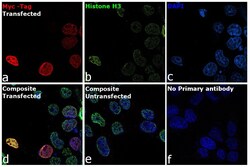
- Experimental details
- Immunofluorescent analysis of Myc tag was performed using 70% confluent His-H3-Myc transfected HEK-293 cells. The cells were fixed with 4% paraformaldehyde for 10 minutes, permeabilized with 0.1% Triton™ X-100 for 15 minutes, and blocked with 2% BSA for 1 hour at room temperature. The cells were labeled with Myc Tag Monoclonal Antibody (Product # MA1-980-1MG) at 1:100 dilution and Histone H3 antibody (Product # 711055) at 1:200 dilution in 0.1% BSA, incubated at 4 degree Celsius overnight, and then labeled with Goat anti-Mouse IgG (H+L) Highly Cross-Adsorbed Secondary Antibody, Alexa Fluor Plus 647 (Product # A32728) and Goat anti-Rabbit IgG Alexa Fluor Plus 488 (Product # A32731) respectively at a dilution of 1:2000 for 45 minutes at room temperature. Panel a (Nuclei: Red) represents the Myc tag. Panel b (Nuclei: Green) represents Histone H3. Panel c (Nuclei: Blue) represents ProLong™ Diamond Antifade Mountant with DAPI (Product # P36962). Panel d represents the merged image showing the co-localization of nuclear signals in transfected cells. Panel e represents un-transfected HEK-293 cells. Panel f represents control cells with no primary antibody to assess background. The images were captured at 60X magnification.
- Submitted by
- Invitrogen Antibodies (provider)
- Main image

- Experimental details
- Immunofluorescent analysis of c-Myc (green) in H9 embryonic stem cells grown for a few days on Matrigel-coated chamber slides. Cells fixed in 4% paraformaldehyde were permeabilized with 0.1% Triton X-100 for 15 minutes at room temperature. Cells were probed with a c-Myc monoclonal antibody (Product # MA1-980) at a dilution of 1:200 overnight at 4°C, washed with PBST, and incubated with a FITC-conjugated secondary antibody at a dilution of 1:100 for 1 hour at room temperature. Nuclei (blue) were stained with DAPI and cells were analyzed by fluorescence microscopy at 20X magnification.
- Submitted by
- Invitrogen Antibodies (provider)
- Main image

- Experimental details
- Immunofluorescent analysis of c-Myc (green) in HEL 11.4 induced IPS cells grown for a few days on Matrigel-coated chamber slides. Cells fixed in 4% paraformaldehyde were permeabilized with 0.1% Triton X-100 for 15 minutes at room temperature. Cells were probed with a c-Myc monoclonal antibody (Product # MA1-980) at a dilution of 1:200 overnight at 4°C, washed with PBST, and incubated with a FITC-conjugated secondary antibody at a dilution of 1:100 for 1 hour at room temperature. Nuclei (blue) were stained with DAPI and cells were analyzed by fluorescence microscopy at 20X magnification.
- Submitted by
- Invitrogen Antibodies (provider)
- Main image
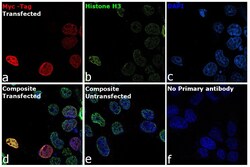
- Experimental details
- Immunofluorescent analysis of Myc tag was performed using 70% confluent His-H3-Myc transfected HEK-293 cells. The cells were fixed with 4% paraformaldehyde for 10 minutes, permeabilized with 0.1% Triton™ X-100 for 15 minutes, and blocked with 2% BSA for 1 hour at room temperature. The cells were labeled with Myc Tag Monoclonal Antibody (Product # MA1-980-1MG) at 1:100 dilution and Histone H3 antibody (Product # 711055) at 1:200 dilution in 0.1% BSA, incubated at 4 degree Celsius overnight, and then labeled with Goat anti-Mouse IgG (H+L) Highly Cross-Adsorbed Secondary Antibody, Alexa Fluor Plus 647 (Product # A32728) and Goat anti-Rabbit IgG Alexa Fluor Plus 488 (Product # A32731) respectively at a dilution of 1:2000 for 45 minutes at room temperature. Panel a (Nuclei: Red) represents the Myc tag. Panel b (Nuclei: Green) represents Histone H3. Panel c (Nuclei: Blue) represents ProLong™ Diamond Antifade Mountant with DAPI (Product # P36962). Panel d represents the merged image showing the co-localization of nuclear signals in transfected cells. Panel e represents un-transfected HEK-293 cells. Panel f represents control cells with no primary antibody to assess background. The images were captured at 60X magnification.
Supportive validation
- Submitted by
- Invitrogen Antibodies (provider)
- Main image
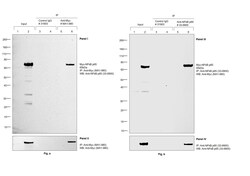
- Experimental details
- Immunoprecipitation (IP) studies of Myc tag were performed with c-Myc Monoclonal Antibody (9E10) (Product # MA1-980) (Panel I, II) or NFkB p65 Monoclonal Antibody (Product # 33-9900) (Panel III, IV) using the Dynabeads® Protein G Immunoprecipitation Kit (Product # 10007D). Lane 1,2: Total cell extract of HEK-293E untransfected (UT) and transfected (T) with Myc-tagged NFkB p65 construct (7% of input) Lane 3,4: IP of UT and T HEK-293E lysate using Isotype-matched Mouse IgG (Product # 31903) Lane 5,6: IP of UT and T HEK-293E lysate with 5 µg of c-Myc Monoclonal Antibody (9E10) (Product # MA1-980) (Panel I, II) (Panel I, II) or NFkB p65 Monoclonal Antibody (Product # 33-9900) (Panel III, IV) IP was analyzed using western blot. Myc-tagged NFkB p65 was detected at ~65 kDa by probing the blot with NFkB p65 Monoclonal Antibody (Product # 33-9900) (0.5 µg/mL dilution) (Panel I, IV) or c-Myc Monoclonal Antibody (9E10) (Product # MA1-980) (1:1,000 dilution) (Panel II, III) and detected by chemiluminescence with Recombinant Protein G-HRP (Product # 101223) (1:500 dilution) using the iBright FL 1500 (Product # A44241). Chemiluminescent detection was performed using Novex® ECL Chemiluminescent Substrate Reagent Kit (Product # WP20005).
Supportive validation
- Submitted by
- Invitrogen Antibodies (provider)
- Main image
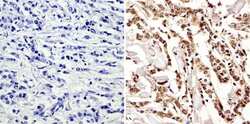
- Experimental details
- Immunohistochemistry was performed on cancer biopsies of deparaffinized Human breast carcinoma tissue. To expose target proteins, heat induced antigen retrieval was performed using 10mM sodium citrate (pH6.0) buffer, microwaved for 8-15 minutes. Following antigen retrieval tissues were blocked in 3% BSA-PBS for 30 minutes at room temperature. Tissues were then probed at a dilution of 1:100 with a Mouse Monoclonal Antibody recognizing c-myc (Product # MA1-980) or without primary antibody (negative control) overnight at 4°C in a humidified chamber. Tissues were washed extensively with PBST and endogenous peroxidase activity was quenched with a peroxidase suppressor. Detection was performed using a biotin-conjugated secondary antibody and SA-HRP, followed by colorimetric detection using DAB. Tissues were counterstained with hematoxylin and prepped for mounting.
- Submitted by
- Invitrogen Antibodies (provider)
- Main image
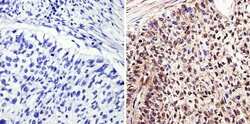
- Experimental details
- Immunohistochemistry was performed on cancer biopsies of deparaffinized Human lung squamous carcinoma tissue. To expose target proteins, heat induced antigen retrieval was performed using 10mM sodium citrate (pH6.0) buffer, microwaved for 8-15 minutes. Following antigen retrieval tissues were blocked in 3% BSA-PBS for 30 minutes at room temperature. Tissues were then probed at a dilution of 1:100 with a Mouse Monoclonal Antibody recognizing c-myc (Product # MA1-980) or without primary antibody (negative control) overnight at 4°C in a humidified chamber. Tissues were washed extensively with PBST and endogenous peroxidase activity was quenched with a peroxidase suppressor. Detection was performed using a biotin-conjugated secondary antibody and SA-HRP, followed by colorimetric detection using DAB. Tissues were counterstained with hematoxylin and prepped for mounting.
- Submitted by
- Invitrogen Antibodies (provider)
- Main image
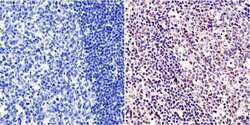
- Experimental details
- Immunohistochemistry was performed on normal biopsies of deparaffinized Human tonsil tissue. To expose target proteins, heat induced antigen retrieval was performed using 10mM sodium citrate (pH6.0) buffer, microwaved for 8-15 minutes. Following antigen retrieval tissues were blocked in 3% BSA-PBS for 30 minutes at room temperature. Tissues were then probed at a dilution of 1:50 with a Mouse Monoclonal Antibody recognizing c-myc (Product # MA1-980) or without primary antibody (negative control) overnight at 4°C in a humidified chamber. Tissues were washed extensively with PBST and endogenous peroxidase activity was quenched with a peroxidase suppressor. Detection was performed using a biotin-conjugated secondary antibody and SA-HRP, followed by colorimetric detection using DAB. Tissues were counterstained with hematoxylin and prepped for mounting.
Supportive validation
- Submitted by
- Invitrogen Antibodies (provider)
- Main image
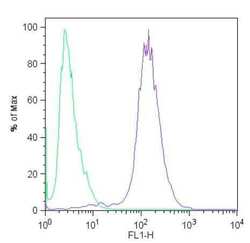
- Experimental details
- Flow cytometric analysis of c-Myc (blue histogram) on HEL 11.4 induced IPS cells. To generate single cells suspensions, colonies were treated with TrypLE cell dissociation enzyme for 5 minutes at 37°C. Cells were incubated with a c-Myc monoclonal antibody (Product # MA1-980) or mouse IgG (green histogram) at a dilution of 1:100 for 1 hour on ice, washed with PBS + 5% fetal calf serum (FACS buffer), and incubated with a FITC-conjugated secondary antibody at a dilution of 1:200 for 30 minutes on ice. Cells were washed with cold FACS buffer, resuspended in 500 µL of FACS buffer containing 10 µL of 4% paraformaldehyde, and analyzed on a flow cytometer.
- Submitted by
- Invitrogen Antibodies (provider)
- Main image
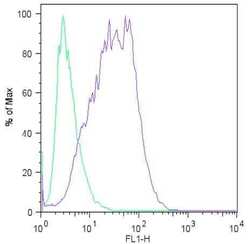
- Experimental details
- Flow cytometric analysis of c-Myc (blue histogram) on H9 embryonic stem cells. To generate single cells suspensions, colonies were treated with TrypLE cell dissociation enzyme for 5 minutes at 37°C. Cells were incubated with a c-Myc monoclonal antibody (Product # MA1-980) or mouse IgG (green histogram) at a dilution of 1:100 for 1 hour on ice, washed with PBS + 5% fetal calf serum (FACS buffer), and incubated with a FITC-conjugated secondary antibody at a dilution of 1:200 for 30 minutes on ice. Cells were washed with cold FACS buffer, resuspended in 500 µL of FACS buffer containing 10 µL of 4% paraformaldehyde, and analyzed on a flow cytometer.
- Submitted by
- Invitrogen Antibodies (provider)
- Main image
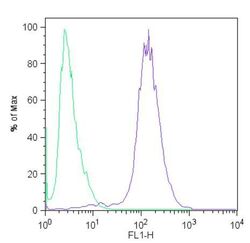
- Experimental details
- Flow cytometric analysis of c-Myc (blue histogram) on HEL 11.4 induced IPS cells. To generate single cells suspensions, colonies were treated with TrypLE cell dissociation enzyme for 5 minutes at 37°C. Cells were incubated with a c-Myc monoclonal antibody (Product # MA1-980) or mouse IgG (green histogram) at a dilution of 1:100 for 1 hour on ice, washed with PBS + 5% fetal calf serum (FACS buffer), and incubated with a FITC-conjugated secondary antibody at a dilution of 1:200 for 30 minutes on ice. Cells were washed with cold FACS buffer, resuspended in 500 µL of FACS buffer containing 10 µL of 4% paraformaldehyde, and analyzed on a flow cytometer.
- Submitted by
- Invitrogen Antibodies (provider)
- Main image
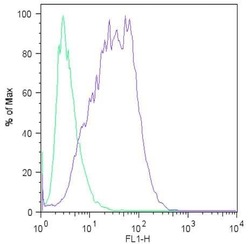
- Experimental details
- Flow cytometric analysis of c-Myc (blue histogram) on H9 embryonic stem cells. To generate single cells suspensions, colonies were treated with TrypLE cell dissociation enzyme for 5 minutes at 37°C. Cells were incubated with a c-Myc monoclonal antibody (Product # MA1-980) or mouse IgG (green histogram) at a dilution of 1:100 for 1 hour on ice, washed with PBS + 5% fetal calf serum (FACS buffer), and incubated with a FITC-conjugated secondary antibody at a dilution of 1:200 for 30 minutes on ice. Cells were washed with cold FACS buffer, resuspended in 500 µL of FACS buffer containing 10 µL of 4% paraformaldehyde, and analyzed on a flow cytometer.
Supportive validation
- Submitted by
- Invitrogen Antibodies (provider)
- Main image
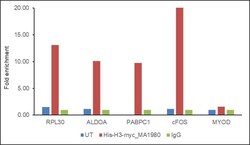
- Experimental details
- HEK293E cells were either untransfected or transfected with an Myc-Tagged Human H3 construct. Chromatin Immunoprecipitation (ChIP) was performed using target H3 antibody (Product # 711055) or c-Myc Monoclonal Antibody (9E10) (Product # MA1-980, 5 µg) on sheared chromatin from untransfected and myc tag transfected HEK293E cells using the MAGnify ChIP System kit (Product # 49-2024). Normal Rabbit IgG was used as a negative IP control for target H3 antibody and Normal Mouse IgG for Myc Tag antibody. The purified DNA was analyzed by qPCR using primers binding to RPL30, ALDOA, PABPC1, cFOS and MYOD. Data is presented as fold enrichment of the antibody signal in untransfected and Myc tagged Human H3 construct transfected cells versus the negative control IgG using the comparative CT method.
- Submitted by
- Invitrogen Antibodies (provider)
- Main image
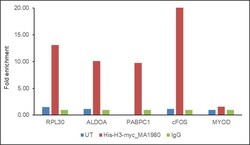
- Experimental details
- HEK293E cells were either untransfected or transfected with an Myc-Tagged Human H3 construct. Chromatin Immunoprecipitation (ChIP) was performed using target H3 antibody (Product # 711055) or c-Myc Monoclonal Antibody (9E10) (Product # MA1-980, 5 µg) on sheared chromatin from untransfected and myc tag transfected HEK293E cells using the MAGnify ChIP System kit (Product # 49-2024). Normal Rabbit IgG was used as a negative IP control for target H3 antibody and Normal Mouse IgG for Myc Tag antibody. The purified DNA was analyzed by qPCR using primers binding to RPL30, ALDOA, PABPC1, cFOS and MYOD. Data is presented as fold enrichment of the antibody signal in untransfected and Myc tagged Human H3 construct transfected cells versus the negative control IgG using the comparative CT method.
Supportive validation
- Submitted by
- Invitrogen Antibodies (provider)
- Main image
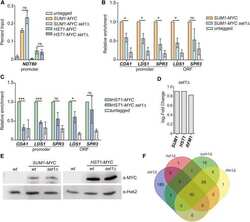
- Experimental details
- NULL
- Submitted by
- Invitrogen Antibodies (provider)
- Main image
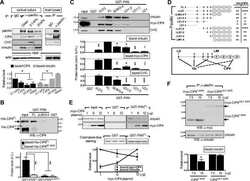
- Experimental details
- NULL
- Submitted by
- Invitrogen Antibodies (provider)
- Main image
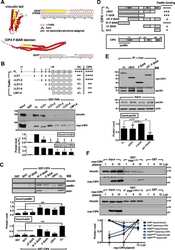
- Experimental details
- NULL
- Submitted by
- Invitrogen Antibodies (provider)
- Main image
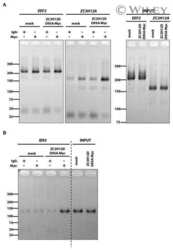
- Experimental details
- NULL
- Submitted by
- Invitrogen Antibodies (provider)
- Main image
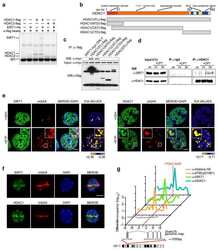
- Experimental details
- NULL
- Submitted by
- Invitrogen Antibodies (provider)
- Main image
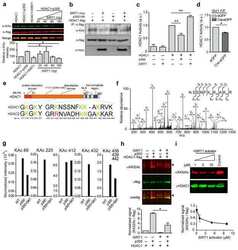
- Experimental details
- NULL
- Submitted by
- Invitrogen Antibodies (provider)
- Main image
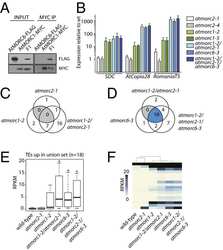
- Experimental details
- NULL
- Submitted by
- Invitrogen Antibodies (provider)
- Main image

- Experimental details
- NULL
- Submitted by
- Invitrogen Antibodies (provider)
- Main image
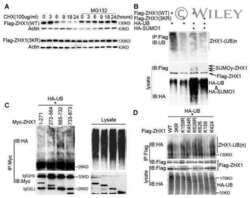
- Experimental details
- NULL
- Submitted by
- Invitrogen Antibodies (provider)
- Main image
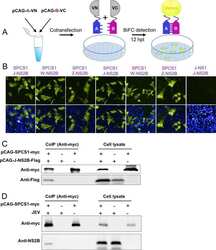
- Experimental details
- NULL
- Submitted by
- Invitrogen Antibodies (provider)
- Main image
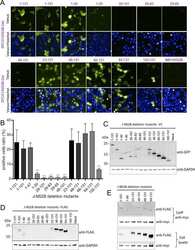
- Experimental details
- NULL
- Submitted by
- Invitrogen Antibodies (provider)
- Main image
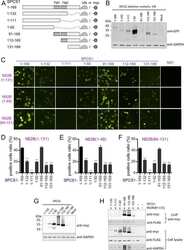
- Experimental details
- NULL
- Submitted by
- Invitrogen Antibodies (provider)
- Main image
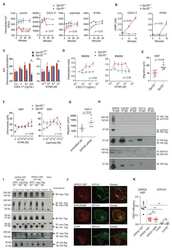
- Experimental details
- NULL
- Submitted by
- Invitrogen Antibodies (provider)
- Main image
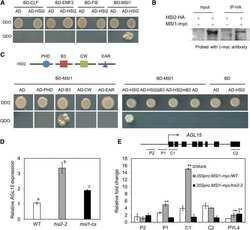
- Experimental details
- NULL
- Submitted by
- Invitrogen Antibodies (provider)
- Main image
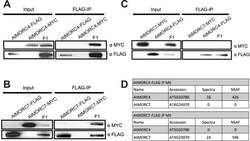
- Experimental details
- Fig 2 AtMORC4 and AtMORC7 form homomeric complexes in vivo . (A) Co-immunoprecipitation of AtMORC4-MYC with AtMORC4-FLAG in F1 plants (B) Co-immunoprecipitation of AtMORC7-MYC with AtMORC7-FLAG in F1 plants. (C) No interaction by co-immunoprecipitation between AtMORC7-MYC and AtMORC4-FLAG in F1 plants. (D) Table from immunoprecipitation followed by mass spectrometry (IP-MS) of FLAG tagged AtMORC4 and AtMORC7 plants showing peptides from themselves but not each other. NSAF = normalized spectral abundance factor.
- Submitted by
- Invitrogen Antibodies (provider)
- Main image
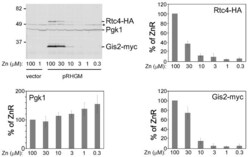
- Experimental details
- Figure 3 Correlation Rtc4 and Gis2 protein expression in response to zinc status. Wild-type (BY4741) cells transformed with plasmid pRHGM were grown in LZM with the indicated zinc level for 16 h prior to immunoblot analysis. pRHGM expresses HA-tagged Rtc4 and myc-tagged Gis2. Pgk1 was used as a loading control and the asterisk marks a non-specific band. The location of size markers is indicated on the left side of the panel in kDa. The histograms show quantified results from three replicates compared to 100 uM zinc cultures as the replete (ZnR) condition. Error bars are +- 1 SD.
- Submitted by
- Invitrogen Antibodies (provider)
- Main image
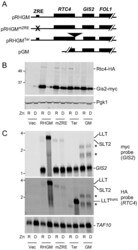
- Experimental details
- Figure 5 Mutagenesis analysis of RTC4 and GIS2 co-regulation. Wild-type (BY4741) cells were transformed with plasmids pRHGM, pRHGM mZRE , pRHGM Ter , or pGM were grown in grown in zinc-replete (R, LZM + 100 uM ZnCl 2 ) or deficient (D, LZM + 1 uM ZnCl 2 ) media prior to analysis. ( A ) Diagram of the plasmids used in this experiment. ( B ) Immunoblot analysis of Rtc4-HA, Gis2-myc, and Pgk1. ( C ) Northern blot analysis of RNA expression using HA tag and myc tag-specific probes. TAF10 was used as a loading control. The locations of the GIS2 and RTC4 SLT2 mRNAs are marked as well as the LLT RNA and truncated LLT RNA produced in the pRHGM Ter transformant. RTC4 SLT1 was not detectable in this experiment because of its low abundance. The asterisks mark two transcripts that arise from transcription initiation in the plasmid vector for pGM. The location of size markers is indicated on the left side of each panel in kDa (panel B) or kb (panel C).
- Submitted by
- Invitrogen Antibodies (provider)
- Main image
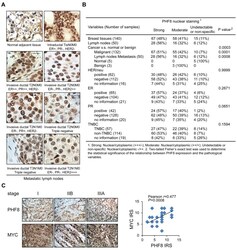
- Experimental details
- Figure 7. PHF8 is upregulated in breast cancers. ( A ) IHC analysis of PHF8 expression in human breast cancer samples. Status of markers associated with locations and stages are listed for each tumor. Scale bar: 10 mum. ( B ) Summary of PHF8 immunohistochemical staining of 190 breast cancer, metastatic lymph nodes and adjacent normal tissues. ( C ) IHC analysis of the expression levels of PHF8 and MYC in 46 breast cancer samples. Representative images (original magnification, x400) from breast carcinoma samples at different stages are shown. The immunoreactive score (IRS) was determined by staining intensity and distribution. The correlation coefficient ( r ) and P values were analyzed as indicated (right panel).
- Submitted by
- Invitrogen Antibodies (provider)
- Main image
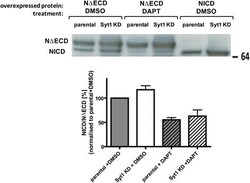
- Experimental details
- Fig. 9 Notch1 intracellular domain (NICD) generation is not affected in Syt1 KD PC12 cells. Parental and Syt1 KD PC12 cells were transfected with Myc-tagged, constitutively active Notch1 with deleted extracellular domain (NDeltaECD), which is an immediate substrate of the gamma-secretase. The cells were treated with DMSO or gamma-secretase inhibitor -- DAPT. Transfection with a plasmid encoding Notch1 intracellular domain (NICD) was used as a control. Western blot analysis shows no difference in the production of the Notch1 intracellular domain, as detected by anti-myc antibody, between parental and Syt1 KD PC12 cells. Data are presented as the NICD/NDeltaECD ratio; mean +- SEM, n = 4. Statistical significance was determined using unpaired student t -test. Syt1 synaptotagmin 1
- Submitted by
- Invitrogen Antibodies (provider)
- Main image
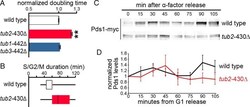
- Experimental details
- FIGURE 2: beta-CTT promotes normal cell cycle progression. (A) Normalized doubling times for WT and CTT mutant cells. Values are the mean from at least four separate experiments. Error bars are SEM. ** p < 0.0001 determined by t test. (B) Duration of S/G2/M determined by measuring the time from bud emergence to separation in cells released from START. Dashed lines are the medians. WT, n = 617; tub2-430Delta, n = 561. (C) Time course of Pds1/securin levels in synchronized cells released from START. Cells expressing Pds1-13myc were collected at 15- min intervals, prepared for Western blots, and probed with myc antibodies. (D) Pds1-13myc signal at each time point normalized to t = 0. Values are averages from three experiments. Error bars are SEM.
- Submitted by
- Invitrogen Antibodies (provider)
- Main image
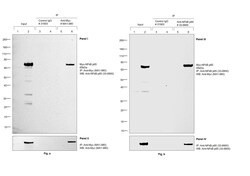
- Experimental details
- Immunoprecipitation (IP) studies of Myc tag were performed with c-Myc Monoclonal Antibody (9E10) (Product # MA1-980) (Panel I, II) or NFkB p65 Monoclonal Antibody (Product # 33-9900) (Panel III, IV) using the Dynabeads® Protein G Immunoprecipitation Kit (Product # 10007D). Lane 1,2: Total cell extract of HEK-293E untransfected (UT) and transfected (T) with Myc-tagged NFkB p65 construct (7% of input) Lane 3,4: IP of UT and T HEK-293E lysate using Isotype-matched Mouse IgG (Product # 31903) Lane 5,6: IP of UT and T HEK-293E lysate with 5 µg of c-Myc Monoclonal Antibody (9E10) (Product # MA1-980) (Panel I, II) (Panel I, II) or NFkB p65 Monoclonal Antibody (Product # 33-9900) (Panel III, IV) IP was analyzed using western blot. Myc-tagged NFkB p65 was detected at ~65 kDa by probing the blot with NFkB p65 Monoclonal Antibody (Product # 33-9900) (0.5 µg/mL dilution) (Panel I, IV) or c-Myc Monoclonal Antibody (9E10) (Product # MA1-980) (1:1,000 dilution) (Panel II, III) and detected by chemiluminescence with Recombinant Protein G-HRP (Product # 101223) (1:500 dilution) using the iBright FL 1500 (Product # A44241). Chemiluminescent detection was performed using Novex® ECL Chemiluminescent Substrate Reagent Kit (Product # WP20005).
- Submitted by
- Invitrogen Antibodies (provider)
- Main image
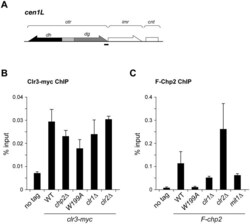
- Experimental details
- Fig 5 Interdependency of SHREC components to associate with heterochromatin. (A) Schematic diagram of the left half of centromere 1. Position of the PCR product used to detect Clr3-myc in (B) and F-Chp2 in (C) is indicated by a thick bar. (B,C) ChIP assay showing Clr3-myc (B) or F-Chp2 (C) levels at centromeric dg . The values were normalized to input. Error bars indicate standard errors from three biological replicates. The strains used were PJ1323 (wt), PJ 1600 ( clr3-myc ), EO1001 ( clr3-myc , chp2 Delta), EO1002 ( clr3-myc , F-chp2-W199 ), EO1003 ( clr3-myc , clr1 Delta), EO1004 ( clr3-myc , clr2 Delta), PJ1566 ( F-chp2 ), EO1005 ( F-chp2-W199A ), EO1006 ( F-chp2 , clr1 Delta), EO1007 ( F-chp2 , clr1 Delta), and EO1006 ( F-chp2 , mit1 Delta).
- Submitted by
- Invitrogen Antibodies (provider)
- Main image
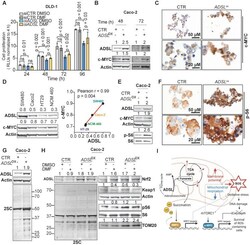
- Experimental details
- Figure 6 ADSL overexpression induces succination and mTOR activation and increases c-MYC protein expression. ( A ) Proliferation capacity of DLD-1 control and ADSL -silenced cells treated with DMSO or fumarate (50 uM). ( B ) Immunoblot showing ADSL and c-MYC expression in the Caco-2 cells at 48 and 72 h post transfection. ( C ) Representative pictures of control and ADSL -overexpressing Caco-2 cells immunostained with c-MYC. Scale bars 20-50 um. ( D ) Immunoblot showing ADSL and c-MYC expression in CRC cell lines (left). Correlation (linear regression) between c-MYC (Y-axis) and ADSL (X-axis) levels of expression (relative to actin). ( E ) Immunoblot showing ADSL, c-MYC and phospho and total S6 expression in Caco-2 cells 48 h post-transfection. ( F ) Representative pictures of control and ADSL -overexpressed Caco-2 cells immunostained with phospho-S6 (p-S6). Scale bars 20-50 um. ( G ) Immunoblot showing ADSL and succination (2-SC) levels in Caco-2 cells 48 h post-transfection. ( H ) Immunoblot showing ADSL and succination (2-SC) levels (left) and KEAP1, NRF2, TOM20, total and phospho-S6 in control and ADSL -overexpressing Caco-2 cells treated with DMSO or fumarate (50 uM). ( I ) Schematic representation of ADSL-driven pro-oncogenic effects in CRC cells.
- Submitted by
- Invitrogen Antibodies (provider)
- Main image
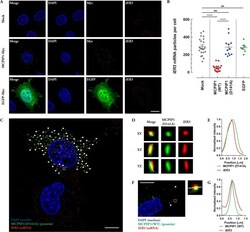
- Experimental details
- Fig. 3. IF-combined smRNA FISH analysis of MCPIP1 protein interaction with IER3 mRNA. (A) Representative fluorescence images of HepG2 cells transfected with empty vector (mock, upper panel) or with expression vectors coding for MCPIP1-MycHis (middle panel) or EGFP-MycHis (lower panel) and subsequently subjected to IF-combined smRNA FISH procedure (DAPI, nuclei; Myc, primary antibody: mouse anti-c-myc, secondary antibody: Alexa Fluor 488-conjugated donkey anti-mouse; EGFP, native fluorescence of EGFP-MycHis; IER3 , probe blend labeled with fluorescent dye Quasar 570). (B) Quantitative analysis of IF-combined smRNA FISH images of HepG2 cells transfected with empty vector (mock) or with expression vectors coding for MCPIP1-MycHis, MCPIP1(D141A)-MycHis or EGFP-MycHis. Column scatter graph presents all analyzed cells with mean number of IER3 mRNA particle count for each experimental variant. Error bars=s.e.m. Applied statistical method: one-way ANOVA with Bonferroni post hoc test. Numbers of analyzed cells: mock, n= 21, MCPIP1-MycHis, n= 17; MCPIP1(D141A)-MycHis, n= 12 and EGFP-MycHis, n= 7. ns, not significant; **** P
- Submitted by
- Invitrogen Antibodies (provider)
- Main image
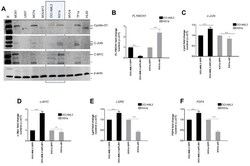
- Experimental details
- Figure 3 FLYWCH1 regulates certain beta-catenin/TCF4 target genes involved in the AML. ( A ) Western blot analysis of beta-catenin target gene expression in AML cell lines using antibodies against cyclin D1, c-Myc, c-Jun, and beta-actin loading control. Asterisks (*) indicate unspecific bands. ( B - F ) Effect of ( B ) FLYWCH1 gene expression modulation on: ( C ) c-JUN , ( D ) c-MYC , ( E ) LGR5 , and ( F ) FGF4 transcription activity. Data are mean +- SD ( n = 6; * p < 0.05; ** p < 0.01; *** p < 0.001).
- Submitted by
- Invitrogen Antibodies (provider)
- Main image
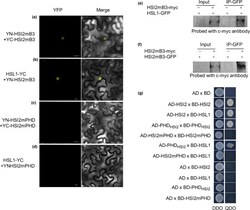
- Experimental details
- Fig. 4 Dimerisation between HSI2 and HSL1 is dependent on PHD-like domain. Bimolecular fluorescence complementation (BiFC) analysis of protein-protein interactions between (a) HSI2mB3:HSI2mB3, (b) HSI2mB3:HSL1, (c) HSI2mPHD:HSI2mPHD and (d) HSI2mPHD:HSL1 using Nicotiana benthamiana leaves co-infiltrated with combinations of corresponding constructs. (e) Co-immunoprecipitation (Co-IP) showing interaction between HSI2mB3 and HSI2mB3 and (f) HSI2mB3 and HSL1. Total protein was extracted from agroinfiltrated tobacco leaves co-expressing 35S:HSI2mB3-GFP and 35S:HSI2mB3-myc , 35S:HSL1-GFP and 35S: HSI2mB3-myc , only 35S:HSI2mB3-GFP or only 35S:HSL1-GFP . HSI2mB3-GFP and HSL1-GFP was immunoprecipitated with anti-GFP antibody and immunoblots were probed with anti-c-myc antibody. (g) Yeast-two-hybrid interaction assays. Yeast cells transformed with indicated genes were selected on Double Dropout medium (DDO, lacking Leu and Trp) and quadruple dropout medium (QDO, lacking adenine, His, Leu and Trp) media.
- Submitted by
- Invitrogen Antibodies (provider)
- Main image
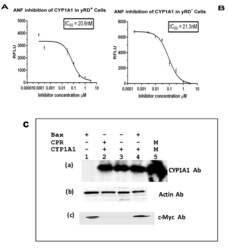
- Experimental details
- Figure 5 IC 50 of alpha-naphthoflavone (ANF) for the inhibition of CYP1A1 enzyme expressed within yRD + and yRD - :: Bax cells. ANF's IC 50 for inhibition of CYP1A1 enzyme that was expressed in live cells. The cells that were used were from strains ( A ) yRD + (+CPR) and ( B ) yRD - :: Bax (-CPR). CYP1A1 enzyme expression was driven by the ethanol-inducible ADH2 promoter (ADH2p). In yRD - cells, Bax expression was driven by the GAL1 promoter (GAL1p), which was de-repressed in ethanol. Recombinant cells were grown for 18 h in YPD liquid medium containing glucose, allowing for around 6 h of induction and de-repression of ADH2p and GAL1p in ethanol (it takes ~12 h for glucose to be utilized and entirely converted to ethanol). Cells were harvested, washed in PBS-saline. The assay included 1 x 10 7 washed cells and 7-ethoxyresorufin (7-ER) as substrates. The x -axis represents the values of the concentration of ANF in uM (ranges from 0.00001 to 3 uM) that were incubated with cells for 10 min, the y -axis relative fluorescence units of the fluorescent product formed. The IC 50 values were calculated using the GraphPad Prism software. T. ANF's IC 50 for inhibition of CYP1A1 Supersomes (insect cell-derived CYP1A1-bearing microsomes; Corning-Gentest, Corning, NY, USA) is 18 nM []. ( C ) Western Blotting of lysates from yRD + , yRD - , and yRD-:: Bax cells expressing CYP1A1. Yeast cell lysates (5 ug of total cellular protein for monitoring CYP1A1 and actin; 50 ug for Bax) fractionated
- Submitted by
- Invitrogen Antibodies (provider)
- Main image
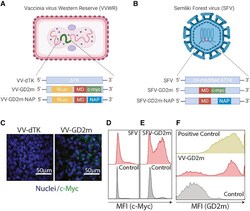
- Experimental details
- Figure 1 Oncolytic Vaccinia virus (VV) and Semliki Forest virus (SFV) encoding the GD2 mimotope (GD2m) (A and B) Schematic illustration of VV Western Reserve (VVWR) and SFV constructs used in the study. (C) GD2m expression in NXS2 tumors injected with VV-dTK or VV-GD2m (i.t. ), visualized by immunohistochemical staining. Tumors were collected 2 days after virus injection, and the tumor tissue section was stained with anti-c-Myc antibody and DAPI. Scale bars, 50 mum. (D and E) GD2m expression in NXS2 tumors injected with SFV or SFV-GD2m (i.t.). Tumors were harvested 2 days after virus injection and single-cell suspension was prepared and stained with anti-c-Myc antibody. Representative histogram figures were shown. (F) Representative histogram showing binding of the anti-GD2 antibody to cells infected with VV-GD2m. B16-F10 cells were infected with VV-GD2m (MOI 0.1) and were collected after 48 h. Cells were stained with anti-GD2 antibody (clone 14G2a) and secondary goat anti-rabbit-AF647 antibody and analyzed by flow cytometry. NXS2 cells (naturally expressing GD2) were used as a positive control. VV-GD2m-infected B16-F10 cells stained with only secondary goat anti-rabbit-AF647 antibody were used as a negative control.
- Submitted by
- Invitrogen Antibodies (provider)
- Main image
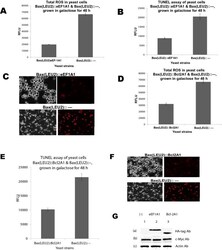
- Experimental details
- Fig. 3 a , d Measurement of ROS produced in the yeast strains Bax(LEU2):: eEF 1A1 ( a ), Bax(LEU2)::Bcl 2A1 ( d ) and Bax(LEU2):: -, a two-tailed paired sample t test show that there was significant difference (p < 0.05). b , e TUNEL assay comparing the nuclear DNA fragmentations in yeast strains Bax(LEU2):: eEF 1A1 ( b ), Bax(LEU2)::Bcl 2A1 ( e ) and Bax(LEU2):: -. The cells Bax(LEU2):: eEF 1A1 and Bax(LEU2)::Bcl 2A1 have lower nuclear DNA fragmentation compared to Bax(LEU2):: - cells. A two tailed paired sample t test show that there was significant difference (p < 0.05). c , f represent microscopic image of cells after tunnel assay, Bax(LEU2):: eEF 1A1 ( c ) and Bax(LEU2)::Bcl 2A1 ( f ). g Western blot to monitor the presence of Bax in yeast cells that express only Bax and in cells that co-express Bax together with eEF-1A1 and, Bcl-2A1. 10 ug of total cellular proteins, in cell lysates, were loaded on to each lane and the blot was probed with an antibody that recognizes the c-myc-tag, Actin, & HA-tag. The plasmid pRS305/GAL1p-h_Bax-MS has restriction sites that cut the plasmid only once (Supporting information Fig. 1). The human Bax gene contains, at the 3'-end, a sequence that codes for the c-myc tag so that expressed protein can be monitored with an antibody that recognizes the c-myc epitope at the C-terminus of Bax protein. Plasmid pSYE239/eEF1A1-HA (Supporting information Fig. 2) is an episomal 2u-plasmid encoding HA-tagged eEF1A1 gene. The plasmid pSYE239/Bcl-2A1-HA i
- Submitted by
- Invitrogen Antibodies (provider)
- Main image
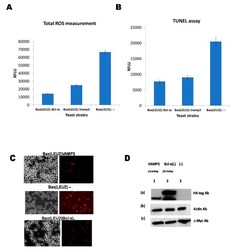
- Experimental details
- Figure 3 Reactive oxygen species (ROS) measurement, terminal deoxynucleotidyl transferase (TdT)-facilitated dUTP nick end labelling (TUNEL) assay, and Western blotting. ( A ) Measurement of ROS produced in the yeast strains Bax(LEU2) + VAMP3, Bax(LEU2) + Bcl xL, and Bax(LEU2) -. A two way ANOVA test shows that there was a significant difference ( p < 0.05) between the control strain and each of Bax + VAMP3 and Bax + Bcl-xL, but there was no significant difference ( p > 0.05) between Bax + VAMP3 and Bax + Bcl-xL. The data represent the mean +- S.D. of three independent experiments. ( B ) TUNEL assay comparing the nuclear DNA fragmentations in yeast strains Bax(LEU2)VAMP3, Bax(LEU2)Bcl xL, and Bax(LEU2). The cells Bax(LEU2)VAMP3 and Bax(LEU2)Bcl xL have lower nuclear DNA fragmentation compared to Bax(LEU2)-cells. A two way ANOVA test shows that there was a significant difference ( p < 0.05) between the control strain and each of Bax + VAMP3 and Bax + Bcl-xL, but there was no significant difference ( p > 0.05) between Bax + VAMP3 and Bax + Bcl-xL. The data represent the mean +- S.D. of three independent experiments. ( C ) Represent the microscopic image of cells after tunnel assay, Bax(LEU2)VAMP3 and Bax(LEU2)Bcl xL. The left images are representative of cells under fluorescent light, showing dead cells (red) (high nuclear fragmentation) . ( D ) Western blot to monitor the presence of Bax in yeast cells that express only Bax and in cells that coexpress Bax together with VAMP3 an
- Submitted by
- Invitrogen Antibodies (provider)
- Main image
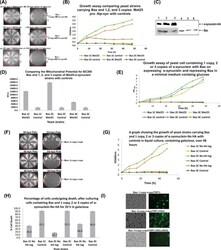
- Experimental details
- Figure 10 Rescue of Bax induced block of cell growth by untagged alpha-synuclein (1-3 copies) on GAL1p and alpha-synuclein-HA (1-3 copies) on MET25p ( A ) Growth on solid agar minimal medium plates of yeast transformants bearing one (1), two (2) or three (3) copies of the alpha-synuclein gene under the control of MET25 promoter (MET-alpha-syn-HA) and Bax gene under the control of GAL1 promoter (Bax). ( B ) Growth of yeast strains containing 1, 2 and 3 copies of alpha-synuclein-HA (MET25p) with a copy of Bax in a minimal liquid medium (SG + 0.1% glucose) along with controls. There was a significant difference among the three yeast strains with their respective controls ( P 0.05), ANOVA test also revealed that there was no significant difference between one and two copies ( P >0.05), but there was a significant difference between two and three copies ( P
- Submitted by
- Invitrogen Antibodies (provider)
- Main image
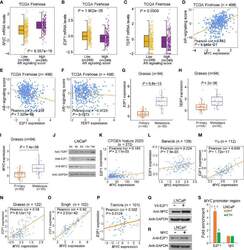
- Experimental details
- Figure 2 Effect of AR singling on E2F1 , MYC , and TERT expression. (A , D) MYC was upregulated in the group with high AR signaling signature score ( SOX9 , RAN , TNK2 , EP300 , PXN , NCOA2 , AR , NRIP1 , NCOR1 , and NCOR2 ). MYC was significantly positively correlated with AR signaling score. (B , E) E2F1 was downregulated in AR signaling high group compared to AR signaling low group. E2F1 was negatively correlated with AR signaling score. (C, F) No significant correlation was observed for TERT upon the AR signaling signature in the TCGA cohort. The Z score sum of the ten-gene AR signaling signature was stratified based on the median score. p- values were calculated using Mann-Whitney U test. (G-I) mRNA levels of E2F1 (G) , TERT (H) , and MYC (I) were elevated in human benign, primary, and metastasis PCa in the Grasso cohort. p- values were calculated using Kruskal-Wallis test. (J) Western blot showing protein levels of TERT, E2F1, and MYC in LNCaP cells with hormone-deprived medium for the indicated days. GAPDH was used as a loading control. (K-O) Expression correlation of MYC with E2F1 in human prostate tissues. Scatter plot showing the direct correlation between MYC with E2F1 expression in the CPGEA cohort ( n = 272) (K) , Barwick cohort ( n = 139) (L) , Yu cohort ( n = 112) (M) , Grasso cohort ( n = 122) (N) Singh cohort ( n = 102) (O) , and Tomlins ( n = 101) (P) . (Q, R) Western blot showing the protein level of MYC in LNCaP cells overexpressing V5 tagged E2F1 (P) and
- Submitted by
- Invitrogen Antibodies (provider)
- Main image
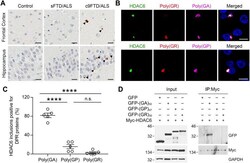
- Experimental details
- FIGURE 1 HDAC6 co-localizes with DPR pathology in c9FTD/ALS. (A) Representative images of immunohistochemical analysis of HDAC6 in frontal cortex (top panels) and hippocampus (bottom panels) from control, sporadic FTD/ALS, or c9FTD/ALS patients ( n = 5 per group). Arrowheads indicate HDAC6 inclusions. Scale bars, 20 mum. (B) Triple-immunofluorescence staining for HDAC6, poly (GR), and either poly (GA) (top panel) or poly (GP) (bottom panel) in the hippocampus of c9FTD/ALS patients. Scale bars, 10 mum. (C) Quantitative analysis of the percentage of HDAC6-positive inclusions that co-localize with poly (GA), poly (GP) and poly (GR) in the hippocampus of c9FTD/ALS patients ( n = 5). Data are presented as mean +- SEM, **** p < 0.0001, one-way ANOVA, Tukey's multiple-comparison test. (D) HEK293T cells were transfected with myc-HDAC6 and GFP, GFP-(GA) 50 , or GFP-(GP) 47 . GFP and myc-HDAC6 levels were evaluated in cell lysates by immunoblotting (left panel), with GAPDH used to control for protein loading. Myc-HDAC6 or GFP were immunoprecipitated from cell lysates, followed by immunoblotting for myc or GFP (right panel).
- Submitted by
- Invitrogen Antibodies (provider)
- Main image
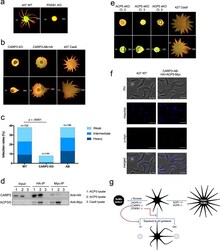
- Experimental details
- Fig. 6 CARP3 is required for acid sensing in vitro and for establishment of infection in flies. a Merged EP and GPEET signals of Lister 427 wt and PDEB1 knockout (KO). b Merged EP and GPEET signals of 427 Cas9 parental line, CARP3 knockout and CARP3-HA addback. Upper panel: untreated. Lower panel: exposed to acid and alkali. c Teneral flies were infected with wild-type Lister 427 procyclic forms (WT), the CARP3 double knockout (CARP3-KO) and the addback (AB). Dissections were performed 13-14 days post infection. Total numbers are derived from two replicates per cell line (Supplementary Table 2 ). The intensity of midgut infections was scored as heavy, intermediate or weak as described . The p-value is shown for Fisher's exact test, two-sided ( p -value = 2.0117 -10 ). d Western blot analysis of immunoprecipitations with anti-HA and anti-myc antibodies (representative blot from three independent experiments). Myc-tagged ACP3 and ACP5 were expressed independently in the CARP3-HA background. The parental line 427 Cas9 was used as a control. Input samples have 40 times fewer cell equivalents than the immunoprecipitated samples. IP: immunoprecipitation with anti-HA or anti-myc antibodies. e Merged EP and GPEET signals of the 427 Cas9 parental line and 3 independent ACP5 single allele knockouts; panels as in ( b ). f Myc-tagged ACP5 is localised to the flagellar tip in a cell line co-expressing CARP3-HA. Immunofluorescence was performed with an anti-myc antibody (red). DNA was stai
- Submitted by
- Invitrogen Antibodies (provider)
- Main image
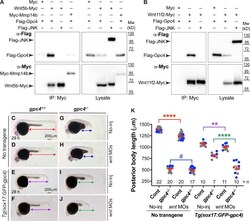
- Experimental details
- Figure 4. The rescue of mesodermal C&E by endodermal expression of GFP-Gpc4 is mediated in part by Wnt5b and Wnt11f2. (A and B) Coimmunoprecipitation experiments were performed using lysates from HEK cells transfected with Myc or Myc-Mmp14b (negative controls), or Wnt5b-Myc or Wnt11f2-Myc and Flag-Gpc4 or Flag-JNK (negative controls) using anti-C-MYC antibody coupled to protein G magnetic beads. Western blotting of in both pellets (IP) and cell lysates (Lysate) was performed using anti-Flag and anti-C-MYC antibodies. Mw, molecular weight. (C-J) Bright-field images of the indicated control embryos and embryos injected with a subdose of MOs targeting wnt11f2/5b (5 and 1 ng). Lateral view. Lines with double arrows indicate posterior body length. Lines of the same color are equal in length. (K) Average posterior body length in embryos shown in C-J, from two independent experiments (represented by different color dots), with the number of embryos indicated. P values in different colors correspond to the embryos with posterior body length marked by the line of that color. Data are mean +- SEM. #, P > 0.05; **, P < 0.01; ****, P < 0.0001; unpaired Student's t test.
- Submitted by
- Invitrogen Antibodies (provider)
- Main image
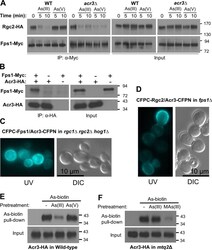
- Experimental details
- Figure 4. Acr3 is a component of the Fps1 complex that regulates Fps1 in response to arsenicals. (A) As(V) treatment induces Fps1 closure in an acr3 Delta mutant. Rgc2-HA and Fps1-Myc were coexpressed (from p3151 and p3121, respectively) in a WT strain (DL3187), or an acr3 Delta mutant (DL4287). The strains were treated with 1 mM As(III) or 3 mM As(V) for the indicated times and processed for co-IP of Rgc2 with Fps1 using anti-Myc antibodies, as in Fig. 1 . (B) Acr3 associates with Fps1. A WT strain (DL3187) coexpressing Fps1-Myc (p3121) and Acr3-HA (p3470) or expressing only one protein was subjected to co-IP analysis using anti-HA antibodies. (C and D) BiFC analysis of Acr3 with known components of the Fps1 complex. An rgc1 Delta rgc2 Delta hog1 Delta strain (C; DL3219) coexpressing CFPC-Fps1 (p3216) and Acr3-CFPN (p3585) was visualized under a UV light source to reveal fluorescence complementation or under visible light (DIC). An fps1 Delta strain (D; DL3226) coexpressing CFPC-Rgc2 (p3584) and Acr3-CFPN (p3585) was visualized as above. Representative micrographs are shown. (E) Pretreatment of WT cells with As(III), but not As(V), blocked As-biotin binding to Acr3-HA. WT strain (DL3187), expressing Acr3-HA (p3470) was pretreated with 1 mM As(III) or 3 mM As(V) for 20 min prior to treatment with 10 muM As-biotin for 10 min. Extracts were subjected to affinity pull-down with SA beads prior to SDS-PAGE and immunoblot analysis for Acr3-HA. (F) Acr3 is a MAs(III) target. An mtq2
- Submitted by
- Invitrogen Antibodies (provider)
- Main image
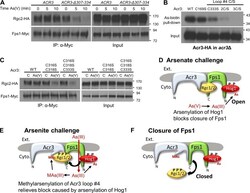
- Experimental details
- Figure 7. Cysteine residues in the Acr3 cytoplasmic loop #4 are modified by MAs(III) and are important for the regulation of Fps1. (A) Effect of Acr3 cytoplasmic loop #4 deletion on Fps1 closure in response to As(V) treatment. An acr3 Delta strain (DL4287) cotransformed with plasmids expressing Fps1-Myc (p3121), Rgc2-HA (p3151) and either ACR3 (p3587) or ACR3-Delta307-334 (p3588) were treated with 3 mM As(V) for the indicated times and processed for co-IP of Rgc2 with Fps1 using anti-Myc antibodies. (B) The three cysteine residues within Acr3 loop #4 account for its As-biotin binding. An acr3 Delta strain (DL4287) expressing the indicated form of Acr3 was treated with 10 uM As-biotin for 10 min. Extracts were subjected to affinity pull-down with SA beads prior to SDS-PAGE and immunoblot analysis for Acr3-HA. Plasmids expressed one of the following ACR3 alleles: ACR3-HA (p3470), acr3-C169S-HA (p3591), acr3-C333S-HA (p3592), acr3-C316S , C318S-HA (2C/S; p3593), or acr3-C316S , C318S , C333S-HA (3C/S; p3594). (C) Cys-to-Ser mutations within Acr3 loop #4 allow closure of Fps1 in response to As(V) treatment. An acr3 Delta strain (DL4287) was cotransformed with plasmids expressing Fps1-Myc (p3121), Rgc2-HA (p3151) and one of the following: ACR3 (p3587), acr3-C316S , C318S (p3589), or acr3-C316S , C318S , C333S (p3590). Strains were either treated with 3 mM As(V) for 10 min or untreated (C) and processed for co-IP of Rgc2 with Fps1. (D) As(V) challenge. As(V) is reduced to As(III),
- Submitted by
- Invitrogen Antibodies (provider)
- Main image
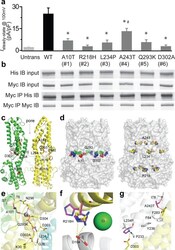
- Experimental details
- Figure 2 Disease-causing mechanisms of BEST1 mutations. ( a ) Bar chart showing population steady-state current densities at 100 mV for transiently expressed BEST1 WT and mutants in HEK293 cells at 1.2 muM [Ca 2+ ] i ; n = 5-6 for each point. * P = 4 x 10 -5 (A10T), 7 x 10 -4 (R218H), 2 x 10 -3 (L234P), 3 x 10 -2 (A243T), 2 x 10 -4 (Q293K), 2 x 10 -3 (D302A), compared to WT, respectively, and # P = 6 x 10 -4 for A243T compared to untransfected cells, using two-tailed unpaired Student t test. ( b ) WT or mutant BEST1-YFP-His was co-transfected with WT BEST1-CFP-Myc to HEK293 cells, and detected by immunoblotting directly in cell lysate (input) or after co-immunoprecipitation. The full-length blots are shown in Fig. S6 . All error bars in this figure represent s.e.m. ( c ) Ribbon diagram of two oppositely facing (144deg) protomers of a BEST1 pentamer are shown with the extracellular side on the top. The side chains of critical residues are in red. ( d ) Location of the patient mutations in relationship to the channel pore, as viewed from the side. A10 (red), Q293 (green) and D302 (blue) are colored differently. R218, L234 and A243 are colored by atoms. ( e ) Possible interactions of the mutated residues. Each monomeric unit is drawn by a different color and the mutated residues are colored in magenta. Coordination bonds and possible hydrogen bonds are illustrated by dotted black and yellow lines, respectively. ( f ) The effect of replacing R218 with H. Possible conformations of
- Submitted by
- Invitrogen Antibodies (provider)
- Main image
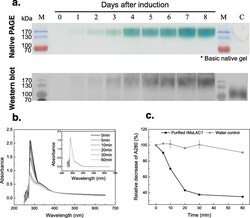
- Experimental details
- Fig. 6 Expression of recombinant MsLAC1 protein and oxidation of sinapyl alcohol by purified recombinant protein. a The protein was expressed in P. pastoris and analyzed by Native PAGE and Western blot. After methanol induction samples of culture medium were collected at daily intervals, cleared by centrifugation, and 10 mul of supernatant were filtered and loaded. The zymogram was stained with 10 mM ABTS. Western blot was developed with anti-MYC antibody. M: PageRular Prestained Protein Ladder, 10-170 kDa. C: Crude extract from fermentation broth of P. pastoris transformed with pPICZalphaAfeh, 8 days after induction. Sinapyl alcohol (final concentration 1 mM) was incubated with 0.002 U recombinant MsLAC1 protein in 50 mM acetate buffer, pH 3.0. b Spectra of reaction mixtures (250 nm - 650 nm) were recorded at indicated time intervals (the insert indicates the control with substrate only). c Time course of absorption change at 280 nm. The initial absorbance at 280 nm was set as 100% individually for the calculation of absorbance decrease with purified protein and water control
- Submitted by
- Invitrogen Antibodies (provider)
- Main image
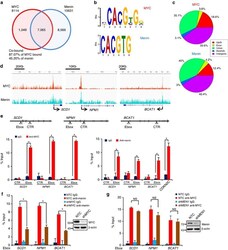
- Experimental details
- Figure 3 Menin and MYC colocalize on chromatin. ( a ) Venn diagram of the ChIP-seq data showing the overlap of genes bound by MYC and Menin. ( b ) Motif enrichment analysis of the sequences at gene promoters from MYC and Menin ChIP-seq data. Consensus E-box sequences (CACGTG) were significantly enriched from both MYC ( P -value
- Submitted by
- Invitrogen Antibodies (provider)
- Main image
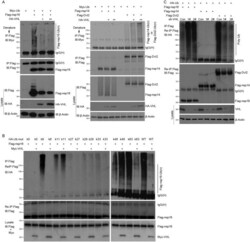
- Experimental details
- Fig. 4 VHL modulates SARS-CoV nsp16 ubiquitination. (A) Left panels, HEK-293T cells were transfected with Myc-ubiquitin, Flag-nsp16 and an increasing amount of HA-VHL (1.0 and 2.0 mug). After 36 h transfection, the cells were collected and denatured in 1% SDS lysis buffer, and the cell lysate were diluted with lysis buffer until the concentration of SDS decreased to 0.1%. The cell extracts were used for co-immunoprecipitation with an anti-Flag antibody. The immunoprecipitates were detected by an anti-Myc or anti-Flag antibody. Right panels, assays were performed as in the left panels. SARS-CoV nsp14 as a negative control and Dvl2 as a positive control. (B) The HA-tagged ubiquitin mutants, Flag-nsp16 and Myc-VHL were transfected into HEK-293T cells. After 36 h, re-IP assays were performed with anti-Flag antibody. The immunoprecipitates were analyzed with an anti-HA or anti-Flag antibody. (C) The HA-ubiquitin, Flag-nsp16 or Flag-nsp14 or Flag-Dvl2, control (PLKO.1) or VHL RNAi plasmids (1# or 2#) were transfected into HEK-293T cells. After 24 h, the cells were treated with puromycin (1 mug/ml) for another 24 h and then lysed for re-IP assays with anti-Flag antibody. The immunoprecipitates were analysed with the anti-HA or anti-Flag antibody (upper panels).
- Submitted by
- Invitrogen Antibodies (provider)
- Main image
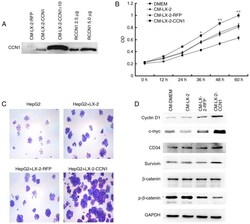
- Experimental details
- Figure 3 CCN1 enhances the function of hepatic stellate cells in promoting the viability of HCCs. (A) Western blot analysis was used to detect expression levels of CCN1 in the original CM and 10X concentration CM collected from LX-2 cells infected with AdCCN1 or AdRFP. Expression levels were also detected following treatment with 2.5 and 5 mu g. HepG2 cells were cultured with or without CM. (B) Viability of HepG2 cells, analyzed using MTT assays. * P
- Submitted by
- Invitrogen Antibodies (provider)
- Main image
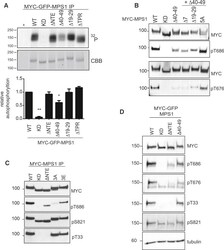
- Experimental details
- Figure 4 Residues 40-49 Form an NTE-Specific Kinase Autoinhibitory Module (A) In vitro kinase assay of MYC-GFP-Mps1 constructs. Coomassie blue staining indicated equal loading. Quantification of Mps1 autophosphorylation is shown; data are means +- SEM; n = 3. * p < 0.05 and ** p < 0.01. (B) Immunoblotting with the indicated antibodies of the various MYC-Mps1 mutant proteins. (C) MYC immunoprecipitates from cells expressing the indicated MYC-Mps1 constructs were resolved by SDS-PAGE and immunoblotted as shown. (D) Cells were treated as in (C), enriched in mitosis with nocodazole, and immunoblotted as indicated. See also Figures S4 and S5 .
- Submitted by
- Invitrogen Antibodies (provider)
- Main image
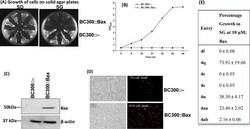
- Experimental details
- Figure 8 (A) Solid agar plates depicting the growth of yeast cellsthatexpress human Bax protein and cells that do not contain Bax, in minimalmedium containing either glucose (SD) or galactose (SG). (B) Growthof one set of clones from the strains, as in (A), in liquid minimalmedium containing galactose (SG); the OD 600 values at eachtime point represent the average of three independent experiments(* P < 0.01; one-tailed Student's t -test). (C) Western blot of total cellular proteins obtainedafter lysis of cells that do not express Bax (BC300::--) anddo express c -myc-tagged Bax (BC300::Bax), probedwith a c -myc antibody (Thermo Scientific, MA 1-980),and a beta-actin antibody (Proteintech, 60008-1-Ig) as a loadingcontrol, beta-actin being a housekeeping gene. (D) Staining ofcells that express BC300::-- and BC300::Bax, with Phloxine B,under the fluorescent microscope. The left-hand panels show cellsin phase contrast microscopy. (E) Rescue from the block in growthof yeast cells that express human Bax, by methoxy-stilbenes, at 10muM. The data represent mean +- SD of four independent experimentswhere optical density at 600 nm (OD 600 ) was measured foreach cell culture.
- Submitted by
- Invitrogen Antibodies (provider)
- Main image
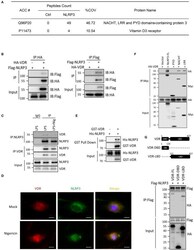
- Experimental details
- Figure 1 VDR interacts with NLRP3. (A) Mass spectrometry analysis of NLRP3 and VDR peptides after immunoprecipitation with Flag to pull down NLRP3-associated proteins in Flag-NLRP3-overexpressing HEK293T cells. (B) HA-VDR was co-expressed with Flag-tagged NLRP3 in HEK293T cells; proteins were immunoprecipitated and analyzed by immunoblotting. Whole-cell lysates are shown as the input. (C) LPS-primed BMDMs were unstimulated or stimulated with nigericin for 30 min. Cell lysates were immunoprecipitated (IP) and immunoblotted (IB) with the indicated antibodies. (D) Immunofluorescent staining for VDR and NLRP3 in LPS-primed BMDMs treated with or without nigericin. Scale bar, 10 mum. (E) Purified GST-VDR was incubated with purified His-NLRP3 for 2 h. His-NLRP3-Flag bound to GST-VDR was pulled down by glutathione beads and subjected to immunoblot analysis. (F) Wild-type or mutant NLRP3 (PYD, NACHT, or LRR) and HA-VDR were expressed in HEK293T cells, immunoprecipitated, and analyzed by immunoblotting. (G) Wild-type or mutant VDR (DBD or LBD) and Flag-NLRP3 were expressed in HEK293T cells, immunoprecipitated, and analyzed by immunoblotting.
- Submitted by
- Invitrogen Antibodies (provider)
- Main image
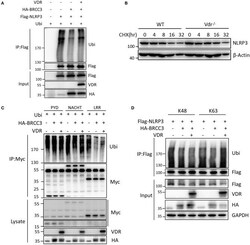
- Experimental details
- Figure 5 Vitamin D receptor inhibits NLRP3 deubiquitination. (A) HEK293T cells were transfected with the indicated vectors. NLRP3 ubiquitination was analyzed. (B) Immunoblot analysis of NLRP3 after treatment of LPS-primed BMDMs (wild-type and Vdr -/- ) with CHX (1 muM) for the indicated time. (C) HEK293T cells expressing HA-BRCC3 and Myc-NLRP3 PYD, NACHT, or LRR were co-transfected with VDR as indicated. Myc-NLRP3 immunoprecipitants were analyzed for ubiquitination. (D) HEK293T cells expressing Flag-NLRP3, HA-BRCC3, and HA-Ubiquitin K63 or K48 were collected, and the cell lysates were immunoprecipitated with the anti-Flag antibody to detect ubiquitination.
- Submitted by
- Invitrogen Antibodies (provider)
- Main image
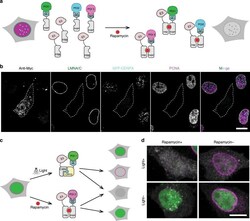
- Experimental details
- Fig. 4 Combinatorial depletion of different sets of multiple proteins. a Schematic outline of the multi-protein targeting DiPD system. Multiple POIs (proteins of interest, POI1-3) are targeted by distinct protein specific targeting modules (Nanobodies, Nbs), which are embedded in the DiPD system. Upon induction with rapamycin the POIs are ubiquitinated and degraded. E3 ubiquitin E3 ligase. b Triple depletion of endogenous LMNA/C, PCNA and GFP-CENPA proteins. GFP-CENPA cells were transfected with DiPD constructs targeting LMNA/C, PCNA and GFP. Proteins were detected by immunostaining or GFP fluorescence after rapamycin treatment. A triple depletion of targeted proteins could be observed in the presence of rapamycin. c Principle of combinatorial light and drug-induced depletion of two independent proteins (POI1 and POI2). d Combinatorial depletion of a nucleoplasmic (GFP-CXXC4, in green) and a nuclear envelope protein (LMNA/C, in magenta). Cells with the light and drug inducible protein depletion tools express DsRed as marker (in gray). Scale bars are 10 um. Extended versions of this figure including uninduced controls are shown in Supplementary FigS. 10 and 11 .
- Submitted by
- Invitrogen Antibodies (provider)
- Main image
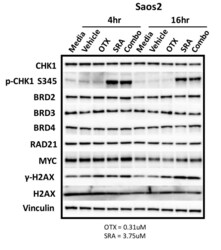
- Experimental details
- Figure 6 BET inhibition as a single agent or in combination with CHK1i/SRA737 does not decrease the MYC protein. Saos2 cells were treated with controls (media and vehicle), as well as single-agent and combination therapy involving BETi/OTX-015 (0.31 uM) and/or CHK1i/SRA737 (3.75 uM) for 4 or 16 h. Concentrations were obtained from data in Table 2 a. Vinculin serves as the loading control. This was performed once. OTX = BETi/OTX-015 and SRA = CHK1i/SRA737.
 Explore
Explore Validate
Validate Learn
Learn Western blot
Western blot ELISA
ELISA Immunocytochemistry
Immunocytochemistry